Paul van Yperen's Blog, page 292
October 22, 2017
Les Vedettes de l'Écran
Last Saturday, EFSP had a post on the Les Vedettes du Cinéma series by French publishing house Éditions Filma. Around the time this series stopped in the early 1920s, Filma started another film star postcard series, Les Vedettes de l'écran (The Stars of the Screen). The numbers of this new set followed the numbers of the first series. In this post, we focus again on postcards with French 'vedettes', but this series also contains many cards of international stars. Next Saturday we continue with another Les Vedettes du Cinéma series, presented during the late 1920s by Paris publisher André Noyer (A.N.)
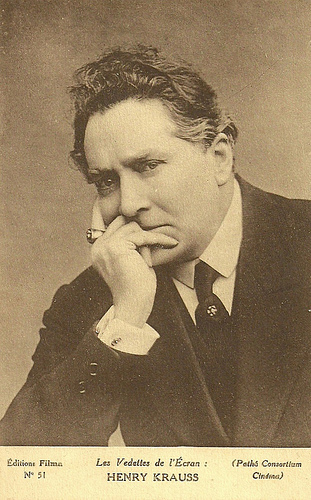
Henry Krauss . French postcard in the Les Vedettes de l'Écran series by Editions Filma, no. 51. Photo: Pathé Consortium Cinéma.
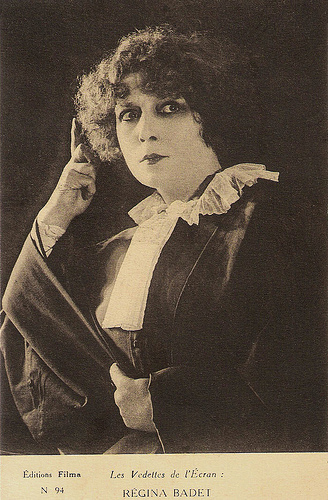
Régina Badet. French postcard in the Les Vedettes de l'Écran series by Editions Filma, no. 94.
During the Belle Epoque, French dancer and actress Régina Badet (1876-1949) was a star of the Opéra-Comique in Paris. She also had a career in the French silent cinema.
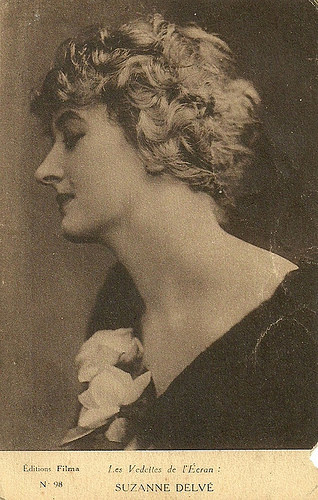
Suzanne Delvé. French postcard in the Les Vedettes de l'Écran series by Editions Filma, no. 98.
Suzanne Delvé (1892-1986) was a French film actress, who peaked in the silent era.
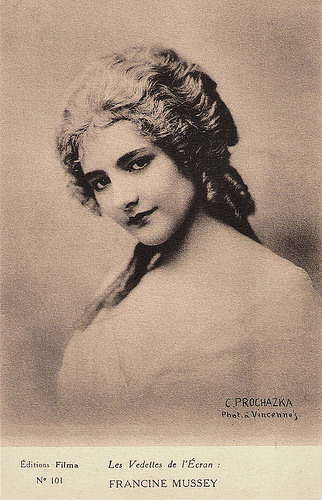
Francine Mussey. French postcard in the Les Vedettes de l'Écran series by Editions Filma, no. 101. Photo: C. Prochazka, Vincennes.
French film actress Francine Mussey (1897-1933) appeared in several French and German films. Her career began in the silent film era of the 1920s and ended in 1933 when she committed suicide by ingesting poison at age 35.
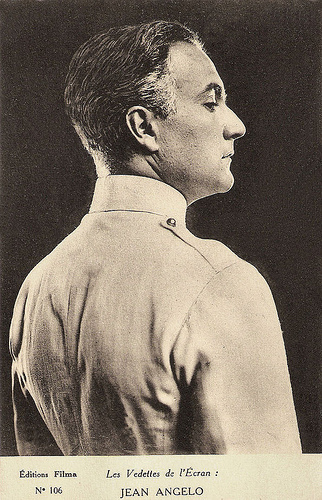
Jean Angelo . French postcard by Editions Filma in the Les Vedettes de l'Écran series, no. 106. Publicity still for L’Atlantide/Lost Atlantis (Jacques Feyder, 1922).
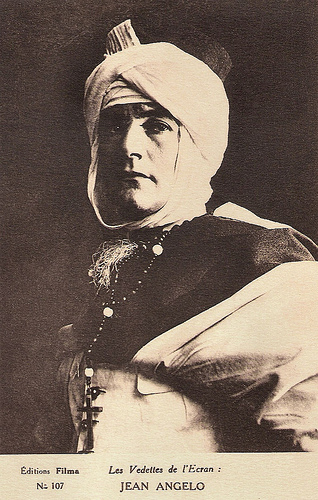
Jean Angelo . French postcard by Editions Filma in the Les vedettes de l'Écran series, no. 107. Publicity still for L’Atlantide/Lost Atlantis (Jacques Feyder, 1922).
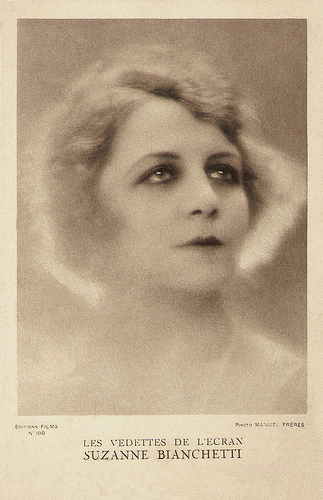
Suzanne Bianchetti . French postcard by Editions Filma in Les Vedettes de l'Écran series, no. 109. Photo: Manuel Frères.
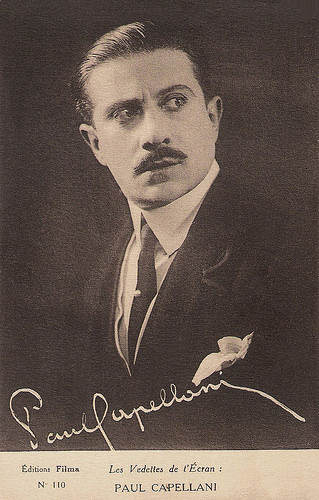
Paul Capellani . French postcard by Editions Filma in Les Vedettes de l'Écran series, no. 110.
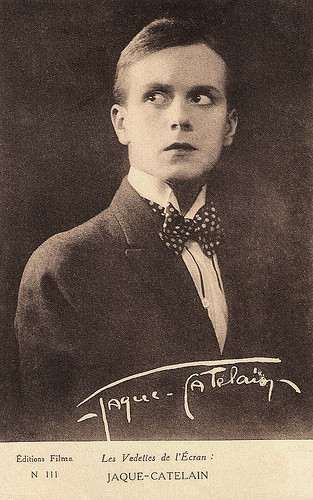
Jaque Catelain . French postcard in the Les Vedettes de l'Écran series by Editions Filma, no. 111.
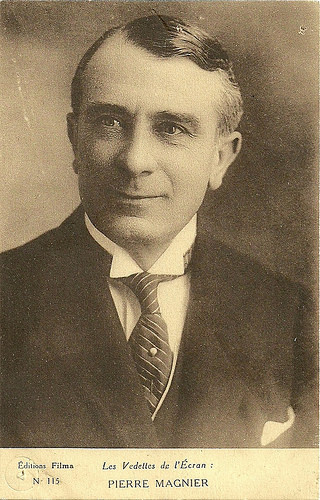
Pierre Magnier. French postcard in the Les Vedettes de l'Écran series by Editions Filma, no. 115.
French stage and screen actor and director Pierre Magnier (1869-1959) acted in over 100 films and was known for e.g. La roue (Abel Gance, 1923), Cyrano de Bergerac (Augusto Genina, 1923) and La règle du jeu (Jean Renoir, 1939).
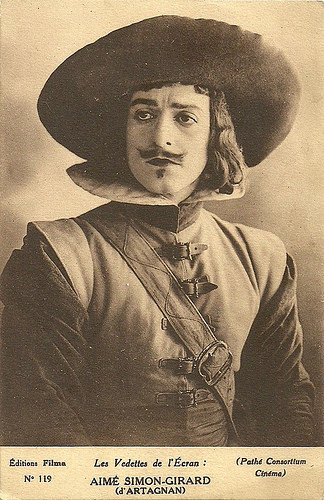
Aimé Simon-Girard as D'Artagnan in Les trois mousquetaires/The Three Musketeers (Henri Diamant-Berger, 1921). French postcard by Editions Filma in the series Les Vedettes de l'Écran, no. 119. Photo: Pathé Consortium Cinéma.
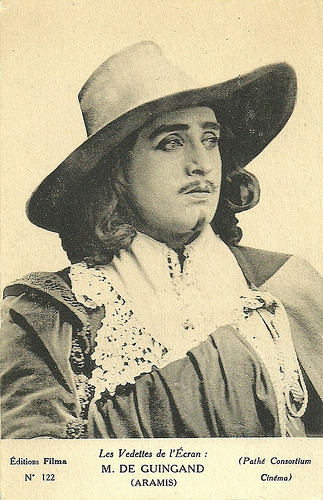
Pierre de Guingand as Aramis in Les trois mousquetaires/The Three Musketeers (Henri Diamant-Berger, 1921). French postcard by Editions Filma in the series Les Vedettes de l'Écran, no. 122. Photo: Pathé Consortium Cinéma.
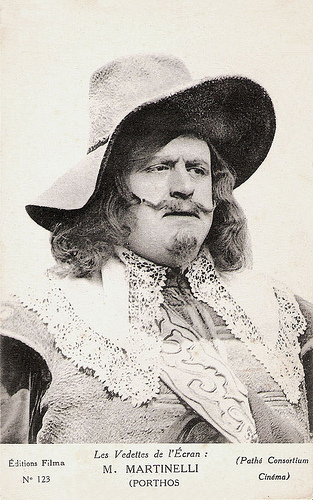
Charles Martinelli as Porthos in Les trois mousquetaires/The Three Musketeers (Henri Diamant-Berger, 1921). French postcard by Editions Filma in the series Les Vedettes de l'Écran, no. 123. Photo: Pathé Consortium Cinéma.
Source: Ross Verlag Movie Star Postcards History and Checklist.

Henry Krauss . French postcard in the Les Vedettes de l'Écran series by Editions Filma, no. 51. Photo: Pathé Consortium Cinéma.

Régina Badet. French postcard in the Les Vedettes de l'Écran series by Editions Filma, no. 94.
During the Belle Epoque, French dancer and actress Régina Badet (1876-1949) was a star of the Opéra-Comique in Paris. She also had a career in the French silent cinema.

Suzanne Delvé. French postcard in the Les Vedettes de l'Écran series by Editions Filma, no. 98.
Suzanne Delvé (1892-1986) was a French film actress, who peaked in the silent era.

Francine Mussey. French postcard in the Les Vedettes de l'Écran series by Editions Filma, no. 101. Photo: C. Prochazka, Vincennes.
French film actress Francine Mussey (1897-1933) appeared in several French and German films. Her career began in the silent film era of the 1920s and ended in 1933 when she committed suicide by ingesting poison at age 35.

Jean Angelo . French postcard by Editions Filma in the Les Vedettes de l'Écran series, no. 106. Publicity still for L’Atlantide/Lost Atlantis (Jacques Feyder, 1922).

Jean Angelo . French postcard by Editions Filma in the Les vedettes de l'Écran series, no. 107. Publicity still for L’Atlantide/Lost Atlantis (Jacques Feyder, 1922).

Suzanne Bianchetti . French postcard by Editions Filma in Les Vedettes de l'Écran series, no. 109. Photo: Manuel Frères.

Paul Capellani . French postcard by Editions Filma in Les Vedettes de l'Écran series, no. 110.

Jaque Catelain . French postcard in the Les Vedettes de l'Écran series by Editions Filma, no. 111.

Pierre Magnier. French postcard in the Les Vedettes de l'Écran series by Editions Filma, no. 115.
French stage and screen actor and director Pierre Magnier (1869-1959) acted in over 100 films and was known for e.g. La roue (Abel Gance, 1923), Cyrano de Bergerac (Augusto Genina, 1923) and La règle du jeu (Jean Renoir, 1939).

Aimé Simon-Girard as D'Artagnan in Les trois mousquetaires/The Three Musketeers (Henri Diamant-Berger, 1921). French postcard by Editions Filma in the series Les Vedettes de l'Écran, no. 119. Photo: Pathé Consortium Cinéma.

Pierre de Guingand as Aramis in Les trois mousquetaires/The Three Musketeers (Henri Diamant-Berger, 1921). French postcard by Editions Filma in the series Les Vedettes de l'Écran, no. 122. Photo: Pathé Consortium Cinéma.

Charles Martinelli as Porthos in Les trois mousquetaires/The Three Musketeers (Henri Diamant-Berger, 1921). French postcard by Editions Filma in the series Les Vedettes de l'Écran, no. 123. Photo: Pathé Consortium Cinéma.
Source: Ross Verlag Movie Star Postcards History and Checklist.
Published on October 22, 2017 22:00
October 21, 2017
In Memoriam Han de Gruiter
Here at EFSP, we love all postcard collectors, but some a little bit more than others. Today we bring a salute to Han de Gruiter, a Dutch collector from The Hague. I once sold him (at Marktplaats, the Dutch equivalent of eBay) a postcard of Brigitte Bardot, his favourite actress, and from then on we corresponded. Like me, he was a fan of another postcard collector, Carla Bosch, with whom he also corresponded. Recently, Carla and I wondered why we did not receive mail anymore from ‘Haegsche Han’, like he called himself. Sadly, Carla discovered our friend had passed away and he is now our guardian angel in film star postcard heaven. Han, Carla and I salute you with this post full of postcards of beautiful women, we know you (would have) loved.
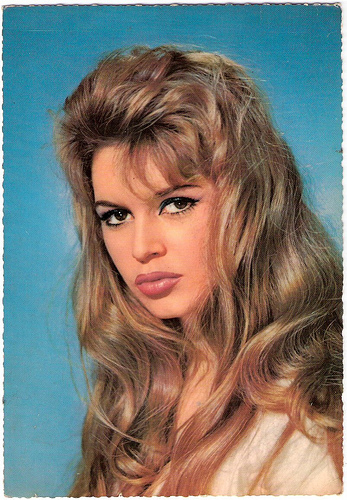
Brigitte Bardot . German postcard by Ufa / Krüger, no. 902/87. Photo: Sam Lévin, 1957.
Paul: "This is the BB card I sold to Han in 2014. Like every Dutch boy who became a man in the 1950s, he loved Bardot. There was even a Dutch hit song at the time: " Brigitte Bardot , Bardot, die heeft ze niet zo, maar zo." (Sorry non-dutchies, untranslatable :)) Back then, I was not born yet, but I can imagine what a sensation she must have been for him. What an erotic glance! A sensual kitten, prrrr."
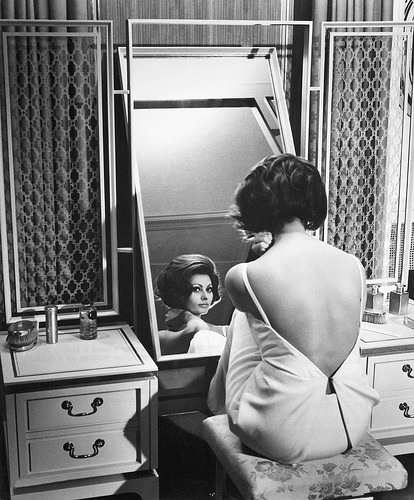
Sophia Loren . Publicity still for A Countess From Hong Kong (Charles Chaplin, 1966). Source: Doctor Macro's.
Carla: "One of the first cards I sold to Han was this card of Sophia Loren in A Countess From Hong Kong. It was a Chinese card which was printed on cheap paper, but Han did not care about that. He bought wat he thought was beautiful or of which he had certain, often fond, memories. And whether they were cheap fake Chinese cards or expensive original Kolibri cards did not matter. What mattered were his memories and he liked to write about them. I am afraid I have lost his first emails. I did, however, find some old notebooks in the attic in which I used to write my first transactions. I saw my contact with Han goes back to January 2010. And I don't have this particular card in my possession anymore as Han bought it. I can see why he thought it was beautiful. If I did not see it, Han would make me see it, he would bear no contradiction."
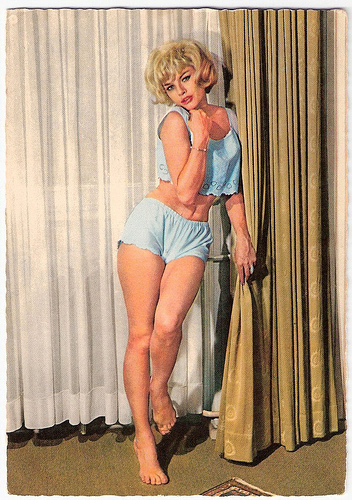
Sophie Hardy . German postcard by Kruger, no. 902/290. Photo: Bernard of Hollywood.
Paul: "Han called Sophie Hardy 'that damn sexy pussycat'. I've never seen a film with her but I guess she was in the France of the 1950s to Brigitte Bardot what Mamie van Doren was in the US to Marilyn Monroe . I like her, but to me the real star of this postcard is the photographer, Bernard of Hollywood . He was a German immigrant who photographed all the glamour ladies of Hollywood, including Marilyn. In the early 1960s, he returned to Germany where he made a series of sizzling pictures for postcards with Jayne Mansfield , Heidi Brühl and Barbara Valentin . And Sophie Hardy ."
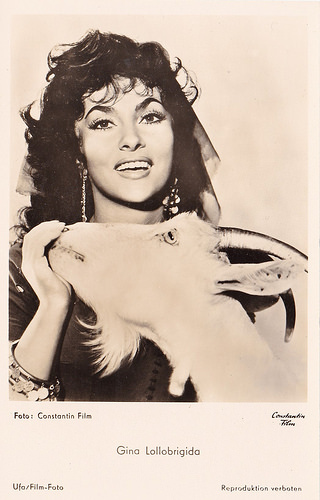
Gina Lollobrigida . German postcard by Ufa, no. FK 3433. Photo: Constantin Film. Collection: Carla Bosch.
Carla: "Han shouted (in writing) 'Those eyes, those eyes, who can resist those eyes!' when he saw this card of Gina Lollobrigida . Gina's eyes were not the first thing that struck me on this card. The goat did. Yet, again Han convinced me those eyes were special. Another buyer was interested in this card, but when Han decided he liked a card, there was no bidder that could defeat him. So he bought the card and gossiped about this other bidder... When he found out that I wrote with Paul too, he immediately suspected we were gossiping about him. Ill doers are ill deemers (or something like that). He forgot that he was likeable, interesting and funny and that to be talked about did not necessarily mean ill talk."
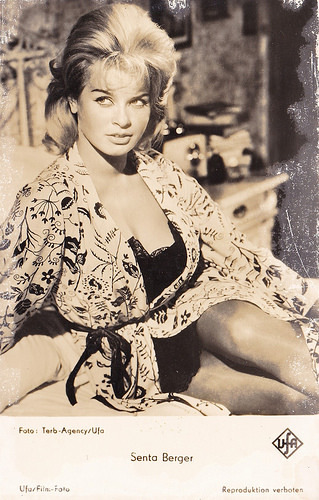
Senta Berger . German postcard by Ufa, no. FK 5162. Photo: Terb Agency / Ufa. Collection: Carla Bosch.
Carla: "Han liked cards of attractive women. He did not buy pin up cards, though I once caught him buying a card of Pamela Anderson in a spectacular red bathing suit. He insisted he liked women who were sexy, but were capable of more than just being beautiful. He acknowledged Pamela was an exception to this rule. Senta Berger was not: apart from being an excellent actress, she was also a shrewd business woman, producer, owner of a film production company.... and pretty. He wrote about her and that is why I look at Senta with different eyes. She had more potential than I thought."
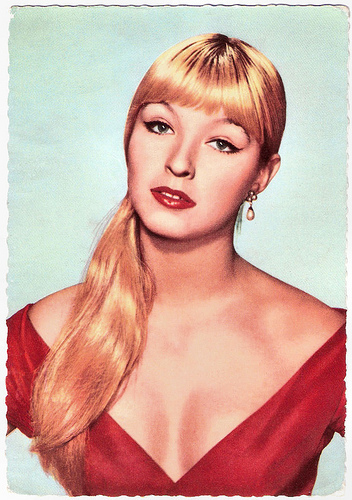
Marina Vlady . German postcard by Ufa, Berlin-Tempelhof, no. CK-76. Photo: Unifrance Film.
Paul: "Han was so happy with this - indeed wonderful - postcard of Vlady, another free-spirited French beauty of the 1950s. Very sexy woman, in a natural way. This picture by Sam Lévin captured her natural allure, don't you think? Did you also wonder if there had been a woman in Han's life? He did write about his neighbours, the young girls next door, his brother and about his former colleagues, but he never wrote about a wife or a girlfriend. He certainly was not shy and as a journalist he must have met countless attractive women. But maybe that is what I liked about him: he kept dreaming. Even when you're 80: stay dreaming, hoping, longing, stay collecting."
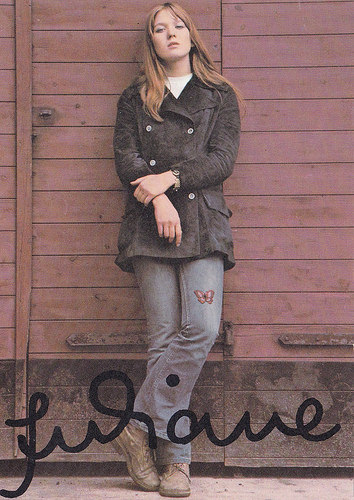
Juliane Werding. German autograph card. Photo: Zill. Collection: Carla Bosch.
Carla: "Yet, sometimes I could neither rhyme nor reason his taste. When I asked him why one woman was more attractive than the other, he answered it would be the same if he asked me why the Ardennes were more attractive than the Botlek. He said he apparently liked women who acted cool and unemotional, not like Dutch Linda de Mol (yes, he really wrote that; I still have the email). One such choice was a card of German singer Juliane Werding. Well, yes, she looks rather cool and tough on this card, but he never said why he chose Juliane Werding. Perhaps because of her 1984 hit song Geh' nicht in die Stadt: in 2015 Han bought a card of Juliane Werding. He wrote he was rather concerned about his neighbourhood. All the people he knew had moved away and he now had the feeling that his beloved neighbourhood, once designed by urban designer Berlage, had become a kind of waiting room for people who were waiting to move again. He felt like Methuselah and I think rather lost, but the children who were new in his street were impressed that he survived the war and trusted him. They became a bridge between him and the changing neighbourhood. He felt well again. So I never knew why Juliane Werding, but this story belongs to one of her cards and I found it one of Han's more interesting purchases."
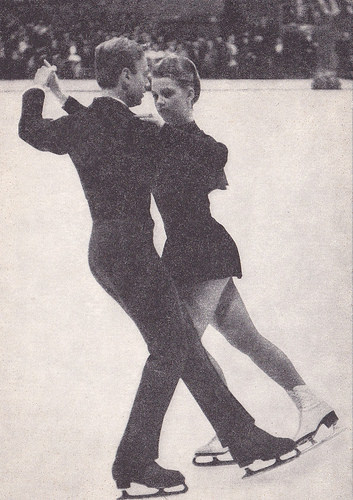
Pavel and Eva Roman. Vintage postcard. No editor. Collection: Carla Bosch.
Carla: "I have many cards with a story connected to Han. This one is a rather surprising choice of his too: Czech ice skating brother and sister Pavel and Eva Roman. Han used to be a sports journalist, so that may explain the subject skating. He also showed a genuine interest in people. He wrote it was so sad that Eva died very young. I had read somewhere that Eva Pavel was living together with Jackie Graham and that it was her brother who had died in a car accident. Han asked who Jackie Graham was and said he sometimes doubted his memory and asked me whether I suffered from memory loss too. I read Pavel's story on the internet, so I had no doubts. Han had the memory of an elephant, but he immediately doubted himself when he mis-remembered something."
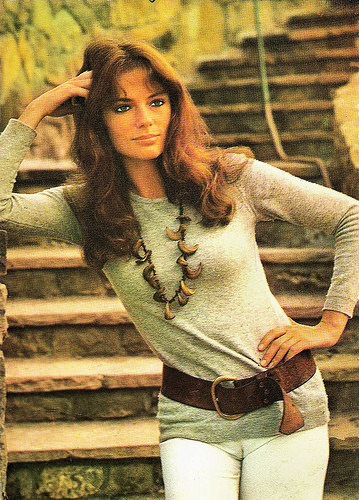
Jacqueline Bisset . Romanian postcard by Casa Filmului Acin.
Paul: "This is a Romanian Acin card I sold to somebody else. And Han mailed me afterwards that he was so mad that he had missed it! He would have paid much more, et cetera. He loved, loved, loved Bisset, he wrote me. Sadly, I could not find another example for him. So I guess this postcard now deserves a place in this I.M. post for him. Recently I saw Jacqueline Bisset in a new film by François Ozon. She was still as elegantly beautiful as ever."
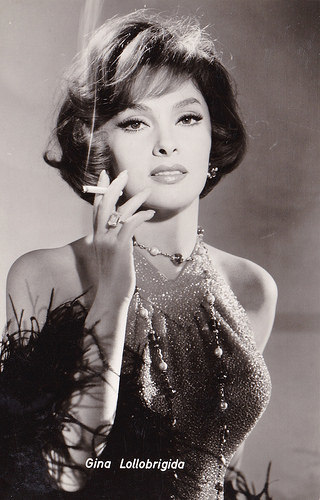
Gina Lollobrigida . German postcard by Kolibri-Verlag, no. 1575. Collection: Carla Bosch.
Carla: "A few years ago, I bid on postcards for my collection on Marktplaats. However, there was another bidder who seemed to have a programme on his computer that notified him each time I bid on a card. He would outbid me within a few minutes. It drove me mad. Han noticed this other bidder. I do not know what he did or said, but it suddenly stopped. I received this card of Gina Lollobrigida and Han asked me whether I knew this rival bidder was a man or woman. I guessed it was a man, Han thought it was a woman. He was the expert... Perhaps he persuaded the woman to give up this card and send it to me. Some time ago, something similar happened when I bid on some of Paul's cards. I was immediately outbid by another bidder. A day later this rival had removed all his bids. Han again? It made us think we have a guardian angel."
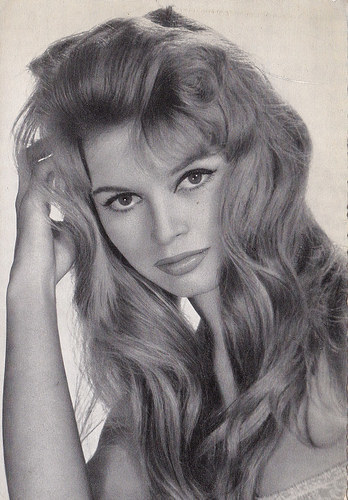
Brigitte Bardot. German postcard by WS-Druck Wanne-Eickel. (I cannot read the number, there is glue on it.) Collection: Carla Bosch.
Carla: "This card of Brigitte Bardot I would have chosen to give as a birthday present. I do not know whether he would have chosen it himself, but I am certain he would have liked it and be a bit embarrassed."
Carla: "I know I chose too many cards! I have many more cards and stories that are connected to Han: postcards of Julie Christie , Raquel Welch , Claudia Cardinale , and why, surprisingly, he had nothing with Michelle Pfeiffer. Yet, I don't want to pretend I knew him that well and write a complete biography about him. It is just that when I looked through my cards and re-read Han's emails, so many stories bubbled up. Too many stories. It was fun to read those stories, Han had a great sense of humour, but it also made me sad, because we discovered too late that he had gone..."
Thanks, Carla, and Han of course!

Brigitte Bardot . German postcard by Ufa / Krüger, no. 902/87. Photo: Sam Lévin, 1957.
Paul: "This is the BB card I sold to Han in 2014. Like every Dutch boy who became a man in the 1950s, he loved Bardot. There was even a Dutch hit song at the time: " Brigitte Bardot , Bardot, die heeft ze niet zo, maar zo." (Sorry non-dutchies, untranslatable :)) Back then, I was not born yet, but I can imagine what a sensation she must have been for him. What an erotic glance! A sensual kitten, prrrr."

Sophia Loren . Publicity still for A Countess From Hong Kong (Charles Chaplin, 1966). Source: Doctor Macro's.
Carla: "One of the first cards I sold to Han was this card of Sophia Loren in A Countess From Hong Kong. It was a Chinese card which was printed on cheap paper, but Han did not care about that. He bought wat he thought was beautiful or of which he had certain, often fond, memories. And whether they were cheap fake Chinese cards or expensive original Kolibri cards did not matter. What mattered were his memories and he liked to write about them. I am afraid I have lost his first emails. I did, however, find some old notebooks in the attic in which I used to write my first transactions. I saw my contact with Han goes back to January 2010. And I don't have this particular card in my possession anymore as Han bought it. I can see why he thought it was beautiful. If I did not see it, Han would make me see it, he would bear no contradiction."

Sophie Hardy . German postcard by Kruger, no. 902/290. Photo: Bernard of Hollywood.
Paul: "Han called Sophie Hardy 'that damn sexy pussycat'. I've never seen a film with her but I guess she was in the France of the 1950s to Brigitte Bardot what Mamie van Doren was in the US to Marilyn Monroe . I like her, but to me the real star of this postcard is the photographer, Bernard of Hollywood . He was a German immigrant who photographed all the glamour ladies of Hollywood, including Marilyn. In the early 1960s, he returned to Germany where he made a series of sizzling pictures for postcards with Jayne Mansfield , Heidi Brühl and Barbara Valentin . And Sophie Hardy ."

Gina Lollobrigida . German postcard by Ufa, no. FK 3433. Photo: Constantin Film. Collection: Carla Bosch.
Carla: "Han shouted (in writing) 'Those eyes, those eyes, who can resist those eyes!' when he saw this card of Gina Lollobrigida . Gina's eyes were not the first thing that struck me on this card. The goat did. Yet, again Han convinced me those eyes were special. Another buyer was interested in this card, but when Han decided he liked a card, there was no bidder that could defeat him. So he bought the card and gossiped about this other bidder... When he found out that I wrote with Paul too, he immediately suspected we were gossiping about him. Ill doers are ill deemers (or something like that). He forgot that he was likeable, interesting and funny and that to be talked about did not necessarily mean ill talk."

Senta Berger . German postcard by Ufa, no. FK 5162. Photo: Terb Agency / Ufa. Collection: Carla Bosch.
Carla: "Han liked cards of attractive women. He did not buy pin up cards, though I once caught him buying a card of Pamela Anderson in a spectacular red bathing suit. He insisted he liked women who were sexy, but were capable of more than just being beautiful. He acknowledged Pamela was an exception to this rule. Senta Berger was not: apart from being an excellent actress, she was also a shrewd business woman, producer, owner of a film production company.... and pretty. He wrote about her and that is why I look at Senta with different eyes. She had more potential than I thought."

Marina Vlady . German postcard by Ufa, Berlin-Tempelhof, no. CK-76. Photo: Unifrance Film.
Paul: "Han was so happy with this - indeed wonderful - postcard of Vlady, another free-spirited French beauty of the 1950s. Very sexy woman, in a natural way. This picture by Sam Lévin captured her natural allure, don't you think? Did you also wonder if there had been a woman in Han's life? He did write about his neighbours, the young girls next door, his brother and about his former colleagues, but he never wrote about a wife or a girlfriend. He certainly was not shy and as a journalist he must have met countless attractive women. But maybe that is what I liked about him: he kept dreaming. Even when you're 80: stay dreaming, hoping, longing, stay collecting."

Juliane Werding. German autograph card. Photo: Zill. Collection: Carla Bosch.
Carla: "Yet, sometimes I could neither rhyme nor reason his taste. When I asked him why one woman was more attractive than the other, he answered it would be the same if he asked me why the Ardennes were more attractive than the Botlek. He said he apparently liked women who acted cool and unemotional, not like Dutch Linda de Mol (yes, he really wrote that; I still have the email). One such choice was a card of German singer Juliane Werding. Well, yes, she looks rather cool and tough on this card, but he never said why he chose Juliane Werding. Perhaps because of her 1984 hit song Geh' nicht in die Stadt: in 2015 Han bought a card of Juliane Werding. He wrote he was rather concerned about his neighbourhood. All the people he knew had moved away and he now had the feeling that his beloved neighbourhood, once designed by urban designer Berlage, had become a kind of waiting room for people who were waiting to move again. He felt like Methuselah and I think rather lost, but the children who were new in his street were impressed that he survived the war and trusted him. They became a bridge between him and the changing neighbourhood. He felt well again. So I never knew why Juliane Werding, but this story belongs to one of her cards and I found it one of Han's more interesting purchases."

Pavel and Eva Roman. Vintage postcard. No editor. Collection: Carla Bosch.
Carla: "I have many cards with a story connected to Han. This one is a rather surprising choice of his too: Czech ice skating brother and sister Pavel and Eva Roman. Han used to be a sports journalist, so that may explain the subject skating. He also showed a genuine interest in people. He wrote it was so sad that Eva died very young. I had read somewhere that Eva Pavel was living together with Jackie Graham and that it was her brother who had died in a car accident. Han asked who Jackie Graham was and said he sometimes doubted his memory and asked me whether I suffered from memory loss too. I read Pavel's story on the internet, so I had no doubts. Han had the memory of an elephant, but he immediately doubted himself when he mis-remembered something."

Jacqueline Bisset . Romanian postcard by Casa Filmului Acin.
Paul: "This is a Romanian Acin card I sold to somebody else. And Han mailed me afterwards that he was so mad that he had missed it! He would have paid much more, et cetera. He loved, loved, loved Bisset, he wrote me. Sadly, I could not find another example for him. So I guess this postcard now deserves a place in this I.M. post for him. Recently I saw Jacqueline Bisset in a new film by François Ozon. She was still as elegantly beautiful as ever."

Gina Lollobrigida . German postcard by Kolibri-Verlag, no. 1575. Collection: Carla Bosch.
Carla: "A few years ago, I bid on postcards for my collection on Marktplaats. However, there was another bidder who seemed to have a programme on his computer that notified him each time I bid on a card. He would outbid me within a few minutes. It drove me mad. Han noticed this other bidder. I do not know what he did or said, but it suddenly stopped. I received this card of Gina Lollobrigida and Han asked me whether I knew this rival bidder was a man or woman. I guessed it was a man, Han thought it was a woman. He was the expert... Perhaps he persuaded the woman to give up this card and send it to me. Some time ago, something similar happened when I bid on some of Paul's cards. I was immediately outbid by another bidder. A day later this rival had removed all his bids. Han again? It made us think we have a guardian angel."

Brigitte Bardot. German postcard by WS-Druck Wanne-Eickel. (I cannot read the number, there is glue on it.) Collection: Carla Bosch.
Carla: "This card of Brigitte Bardot I would have chosen to give as a birthday present. I do not know whether he would have chosen it himself, but I am certain he would have liked it and be a bit embarrassed."
Carla: "I know I chose too many cards! I have many more cards and stories that are connected to Han: postcards of Julie Christie , Raquel Welch , Claudia Cardinale , and why, surprisingly, he had nothing with Michelle Pfeiffer. Yet, I don't want to pretend I knew him that well and write a complete biography about him. It is just that when I looked through my cards and re-read Han's emails, so many stories bubbled up. Too many stories. It was fun to read those stories, Han had a great sense of humour, but it also made me sad, because we discovered too late that he had gone..."
Thanks, Carla, and Han of course!
Published on October 21, 2017 22:00
October 20, 2017
Quo vadis? (1913)
EFSP contributor Ivo Blom speaks today at 'Alma-Tadema: Antiquity at Home and on Screen' in London. This symposium aims to air and develop new research inspired by the exhibition Alma-Tadema: At Home in Antiquity, still on view at London's Leighton House Museum, its third and final venue, till 29 October 2017. The symposium brings together scholars and students from art and design history, architectural history, garden history, classics, classical reception studies, film studies, theatre history, musicology, and Victorian studies among others. Ivo will speak about ‘Art and Art Decoration: Alma-Tadema and Set Design from Guazzoni to Ridley Scott’. So EFSP repeats its post on Guazzoni's colossal epic Quo vadis? (1913), starring Amleto Novelli and Gustavo Serena. All the postcards are from the collection of Ivo Blom.
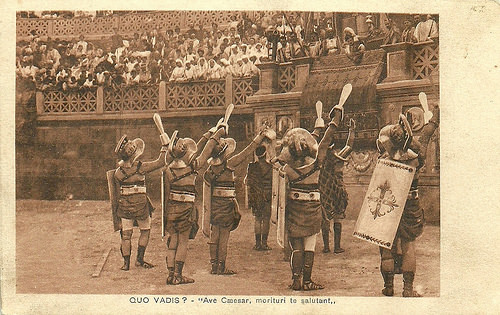
Italian postcard. Photo: Cines. Publicity still for Quo vadis? (Enrico Guazzoni, 1913). Caption: "Ave Caesar, those who are about to die salute you." This image cites a famous 19th century painting (1859) by Jean-Léon Gérôme. It was often quoted, also in the Asterix comics.
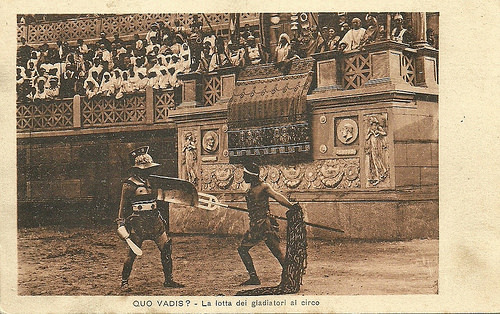
Italian postcard. Photo: Cines. Publicity still for Quo vadis? (Enrico Guazzoni, 1913). Caption: The fight of the gladiators in the arena.
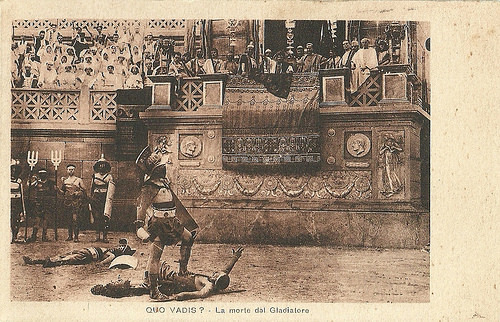
Italian postcard. Photo: Cines. Publicity still for Quo vadis? (Enrico Guazzoni, 1913). Caption: The death of the gladiator. This image cites Jean-Léon Gérôme's famous painting Pollice verso (Thumbs down, 1872) and was often used in the publicity for the film. In the back the emperor Nero (Carlo Cattaneo) makes the sign of thumbs down, sign for the conqueror to kill his adversary. Flanking Nero are left Tigellinus (Cesare Moltroni) and right Petronius ( Gustavo Serena ). Left of the imperial box the Vestal Virgins are seated.
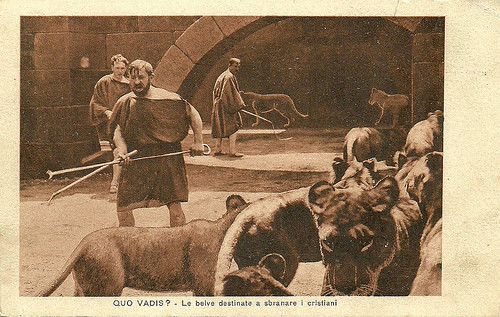
Italian postcard. Photo: Cines. Publicity still for Quo vadis? (Enrico Guazzoni, 1913). Caption: The wild animals destined to tear the Christians to pieces. The lion keepers activate the lions under the circus before sending them above ground.
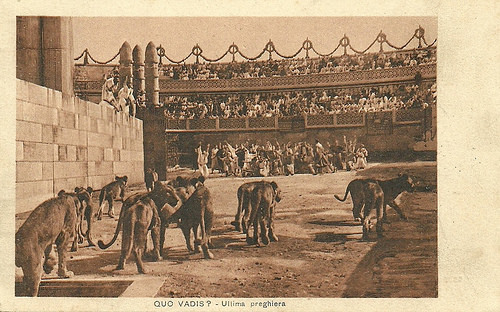
Italian postcard. Photo: Cines. Publicity still for Quo vadis? (Enrico Guazzoni, 1913). Caption: The last prayer. This scene quotes Jean-Léon Gérôme's painting The Christian Martyrs' Last Prayer (1863-1883).
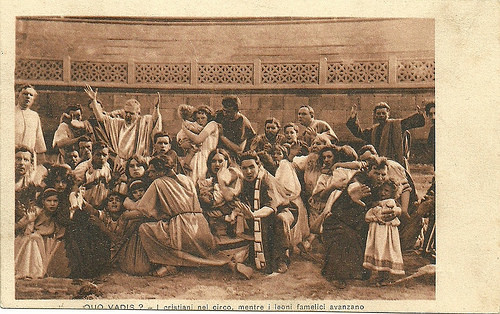
Italian postcard. Photo: Cines. Publicity still for Quo vadis? (Enrico Guazzoni, 1913). Caption: The Christians in the circus, while the hungry lions approach.
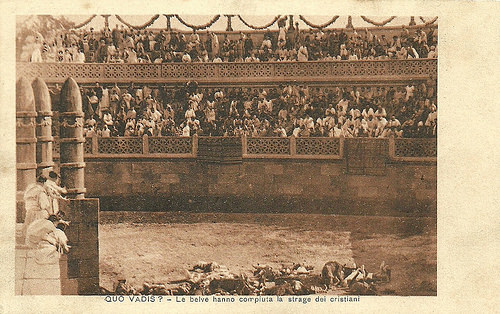
Italian postcard. Photo: Cines. Publicity still for Quo vadis? (Enrico Guazzoni, 1913). The beasts have committed the massacre of the Christians.
Where Are You Going?
Quo vadis? is Latin for 'Where are you going?' and alludes to the apocryphal acts of Peter, in which Peter flees Rome but on his way meets Jesus and asks him why he is going to Rome. Jesus says "I am going back to be crucified again", which makes Peter go back to Rome and accept martyrdom.
Quo vadis? written by Henryk Sienkiewicz tells the love story between a young and beautiful Christian woman, Lygia, and a military tribune and Roman patrician, Marcus Vinicius. The story takes place in the city of Rome under the rule of emperor Nero around AD 64.
Published in installments in three Polish dailies in 1895, Quo vadis? came out in book form in 1896 and has since been translated into more than 50 languages. This novel contributed to Sienkiewicz's Nobel Prize for literature in 1905.
In 1901, Pathé Frères produced the first screen version, Quo vadis? (Lucien Nonguet, Ferdinand Zecca, 1901). It is only 65 meters long (duration: about three minutes) and was recently restored by the Centre national du cinéma et de l’image animée (CNC) in Paris.
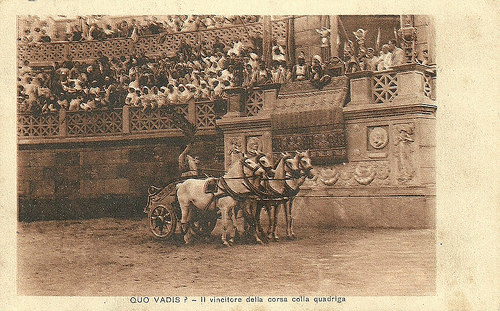
Italian postcard. Photo: Cines. Publicity still for Quo vadis? (Enrico Guazzoni, 1913). Caption: The winner of the chariot race.
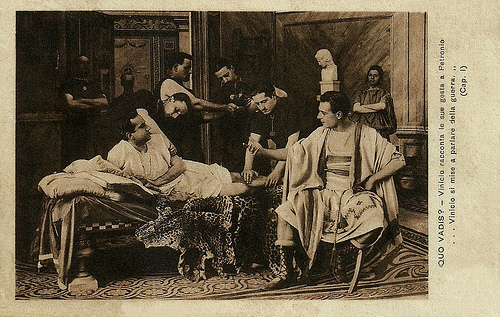
Italian postcard. Photo: Cines. Publicity still for Quo vadis? (Enrico Guazzoni, 1913). Gustavo Serena as Petronius Arbiter and Amleto Novelli as Marcus Vinicius. Caption: Vinicius tells Petronius of his acts. Vinicius started to talk about the war (Chapter I).
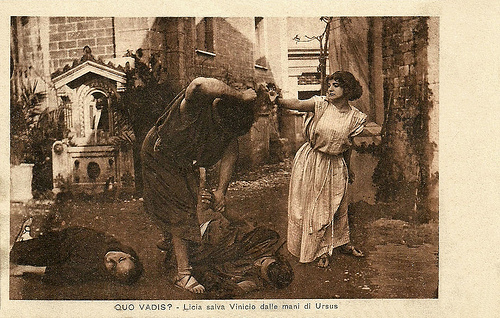
Italian postcard by Uff.Rev. St. Terni. Photo: Cines. Publicity still for Quo vadis? (Enrico Guazzoni, 1913). Lygia ( Lea Giunchi ) saves Vinicius ( Amleto Novelli ) from the hands of Ursus ( Bruto Castellani ). Ursus, protector of Lygia, has just killed a gladiator who had been charged by Vinicius to kill Ursus while he himself planned to abduct Lygia.
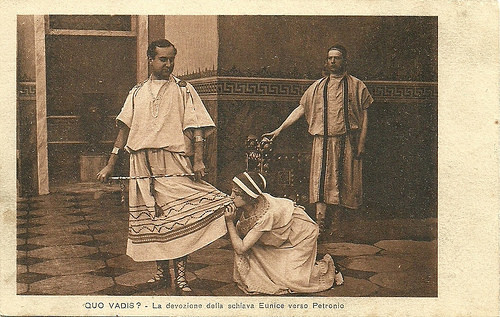
Italian postcard. Photo: Cines. Publicity still for Quo vadis? (Enrico Guazzoni, 1913). Caption: The devotion of the slave Eunice (Amelia Cattaneo) to Petronius ( Gustavo Serena ).
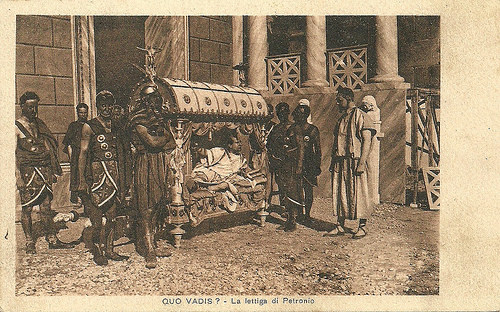
Italian postcard. Photo: Cines. Publicity still for Quo vadis? (Enrico Guazzoni, 1913). Caption: The litter of Petronius. In front of Nero's palace, Petronius ( Gustavo Serena ) says goodbye to his cousin Vinicius (Amleto Novelli) and promises to have a good word to Nero about Vinicius getting Lygia.
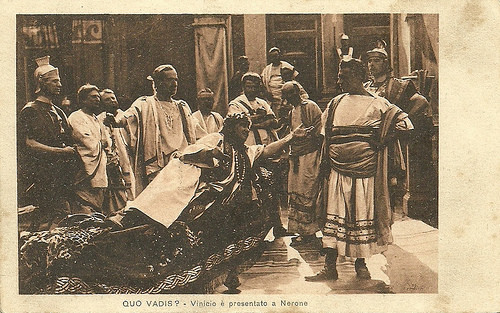
Italian postcard. Photo: Cines. Publicity still for Quo vadis? (Enrico Guazzoni, 1913). Caption: Vinicius ( Amleto Novelli ) is presented to Nero (Carlo Cattaneo). Behind Nero stands Petronius ( Gustavo Serena ).
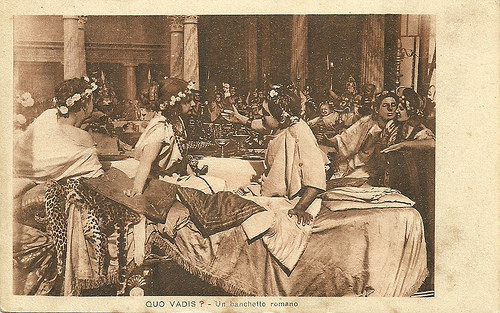
Italian postcard. Photo: Cines. Publicity still for Quo vadis? (Enrico Guazzoni, 1913). A Roman banquet. In the front Lea Giunchi as Lygia and Amleto Novelli as Vinicius.
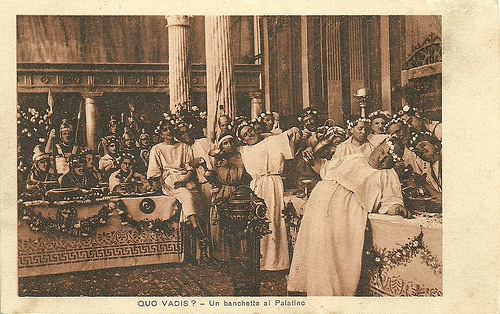
Italian postcard. Photo: Cines. Publicity still for Quo vadis? (Enrico Guazzoni, 1913). Caption: A banquet on the Palatine. The fat and drunken man in front is Giuseppe Gambardella (Vitellius), who was also famous as Checco in short Italian comedies.
A colossal epic
Ten years later, Italian director Enrico Guazzoni made a colossal epic starring Amleto Novelli and Gustavo Serena . He masterly combined huge spectacle with intimate scenes.
In 1913, Guazzoni's Quo vadis? premiered and the results at the box office quickly proved it a smashing success. Wikipedia : "It was arguably the first blockbuster in the history of cinema, with 5,000 extras, lavish sets, and a running time of two hours, setting the standard for 'superspectacles' for decades to come."
Throughout the world, Quo vadis? became popular not only among readers but also among fans of the new phenomenon, cinema. The film influenced Giovanni Pastrone's Cabiria 1914) and D.W. Griffith's Intolerance (1916).
Hal Erickson at AllMovie : "Quo Vadis? is nonetheless an important milestone in movie history. The film ran 12 reels (approximately three hours) at a time when most American productions were still within the 1- to 4-reel length. American film distributor George Kleine pared the film down to 8 reels for US distribution, but this still was an uncommonly long production for its day."
In 1997 the film was restored by the Dutch Filmmuseum (now Eye Institute) in Amsterdam and since then it was shown on several festivals. Tonight it will be screened in Rome.
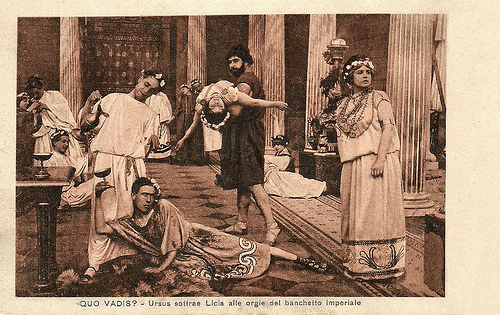
Italian postcard. Photo: Cines. Publicity still for Quo vadis? (Enrico Guazzoni, 1913). Helped by Acte, Nero's former mistress, Ursus ( Bruto Castellani ) subtracts Lygia ( Lea Giunchi ) from the orgy of the imperial banquet, where the drunken Roman Vinicius tries to rape her.
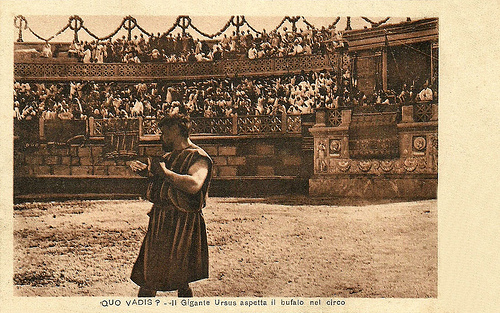
Italian postcard. Photo: Cines. Publicity still for Quo vadis? (Enrico Guazzoni, 1913). The Giant Ursus ( Bruto Castellani ) awaits the bull in the circus. After his long captivity Ursus is almost blinded when he enters the arena. Then a wild bull enters the arena on which back Lygia is bound. Ursus will kill the bull with his bare hands, much to the delight of the audience and the emperor.
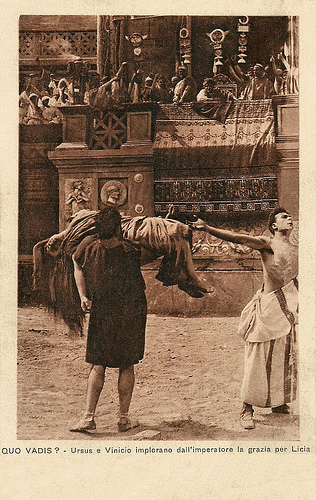
Italian postcard. Photo: Cines. Publicity still for Quo vadis? (Enrico Guazzoni, 1913). Ursus ( Bruto Castellani ) and Vinicius ( Amleto Novelli ) implore the audience and emperor Nero to grace the Christian Lygia ( Lea Giunchi ), after Ursus has killed the bull on whch back Lygia had been bound. The audience raves because of Ursus' tour de force. Vinicius has stripped his cloth to show his scars from the wars, while Ursus holds up Lygia. All around Nero hold their thumbs up for grace, even if this sign seems to have been a 19th century invention and historically incorrect.
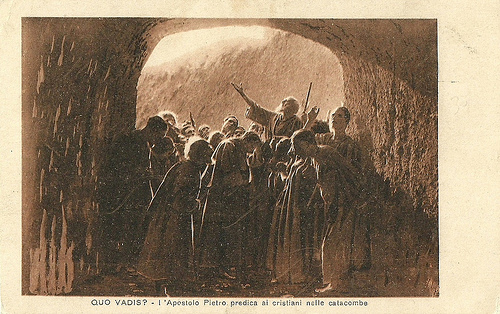
Italian postcard. Photo: Cines. Publicity still for Quo vadis? (Enrico Guazzoni, 1913). Caption: The apostle Peter (Giovanni Gizzi) preaching to the Christians in the catacombs.
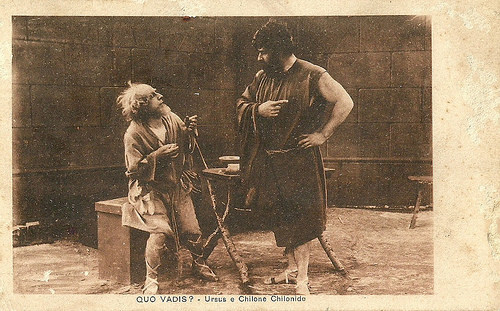
Italian postcard. Photo: Cines. Publicity still for Quo vadis? (Enrico Guazzoni, 1913). Caption: Ursus ( Bruto Castellani ) and Chilo Chilonides (Augusto Mastripietri).
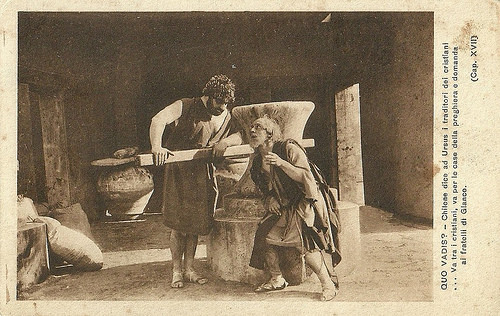
Italian postcard. Photo: Cines. Publicity still for Quo vadis? (Enrico Guazzoni, 1913). Chilo (Augusto Mastripietri) sweettalks to Ursus ( Bruto Castellani ) to find out where Lygia is hidden. Caption: Chilo talks to Ursus about the traitors of the Christians. (Ursus:) Go to the Christians, go to their godhouses and ask for the brothers of Glaucus. (Chapter XVII of the book).
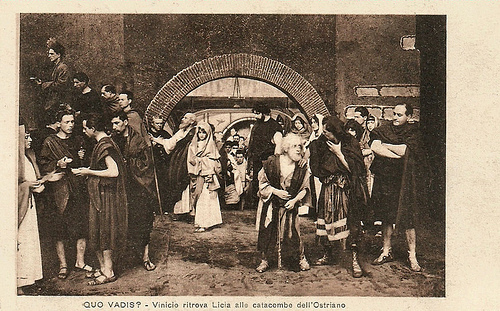
Italian postcard. Photo: Cines. Publicity still for Quo vadis? (Enrico Guazzoni, 1913). Vinicius ( Amleto Novelli ) finds back Lygia ( Lea Giunchi ) at the catacombs of Ostriano. Left of Lygia is St. Peter (Giovanni Gizzi), right of her protector Ursus ( Bruto Castellani ). Vinicius plots to abduct Lygia, with the help of the Greek Chilo (Augusto Mastripietri) and a gladiator.
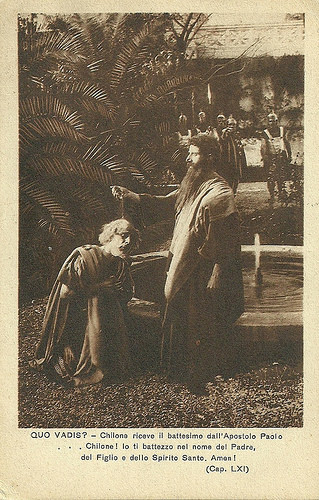
Italian postcard. Photo: Cines. Publicity still for Quo vadis? (Enrico Guazzoni, 1913). Caption: Chilo (Augusto Mastripietri) is baptised by the apostle Paul (of Tarsus). Chilon! I baptise you in the name of the Father, the Son and the Holy Ghost. Amen! (Chapter LXI of the book).
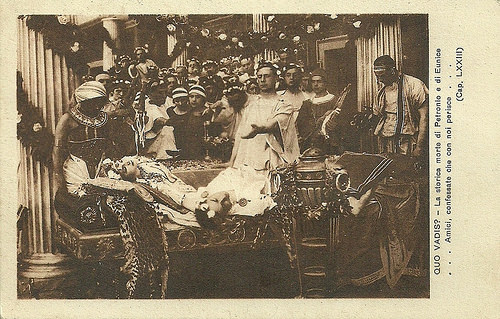
Italian postcard. Photo: Cines. Publicity still for Quo vadis? (Enrico Guazzoni, 1913). Caption: The historical death of Petronius ( Gustavo Serena ) and Eunice (Amelia Cattaneo). "Friends, confess that with us perishes..." (Chapter LXXIII).
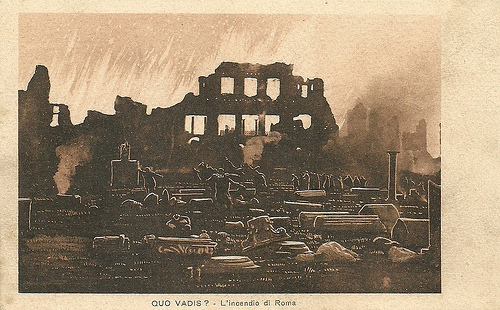
Italian postcard. Photo: Cines. Publicity still for Quo vadis? (Enrico Guazzoni, 1913). Caption: The fire of Rome.
Sources: Hal Erickson (AllMovie), Wikipedia and IMDb.

Italian postcard. Photo: Cines. Publicity still for Quo vadis? (Enrico Guazzoni, 1913). Caption: "Ave Caesar, those who are about to die salute you." This image cites a famous 19th century painting (1859) by Jean-Léon Gérôme. It was often quoted, also in the Asterix comics.

Italian postcard. Photo: Cines. Publicity still for Quo vadis? (Enrico Guazzoni, 1913). Caption: The fight of the gladiators in the arena.

Italian postcard. Photo: Cines. Publicity still for Quo vadis? (Enrico Guazzoni, 1913). Caption: The death of the gladiator. This image cites Jean-Léon Gérôme's famous painting Pollice verso (Thumbs down, 1872) and was often used in the publicity for the film. In the back the emperor Nero (Carlo Cattaneo) makes the sign of thumbs down, sign for the conqueror to kill his adversary. Flanking Nero are left Tigellinus (Cesare Moltroni) and right Petronius ( Gustavo Serena ). Left of the imperial box the Vestal Virgins are seated.

Italian postcard. Photo: Cines. Publicity still for Quo vadis? (Enrico Guazzoni, 1913). Caption: The wild animals destined to tear the Christians to pieces. The lion keepers activate the lions under the circus before sending them above ground.

Italian postcard. Photo: Cines. Publicity still for Quo vadis? (Enrico Guazzoni, 1913). Caption: The last prayer. This scene quotes Jean-Léon Gérôme's painting The Christian Martyrs' Last Prayer (1863-1883).

Italian postcard. Photo: Cines. Publicity still for Quo vadis? (Enrico Guazzoni, 1913). Caption: The Christians in the circus, while the hungry lions approach.

Italian postcard. Photo: Cines. Publicity still for Quo vadis? (Enrico Guazzoni, 1913). The beasts have committed the massacre of the Christians.
Where Are You Going?
Quo vadis? is Latin for 'Where are you going?' and alludes to the apocryphal acts of Peter, in which Peter flees Rome but on his way meets Jesus and asks him why he is going to Rome. Jesus says "I am going back to be crucified again", which makes Peter go back to Rome and accept martyrdom.
Quo vadis? written by Henryk Sienkiewicz tells the love story between a young and beautiful Christian woman, Lygia, and a military tribune and Roman patrician, Marcus Vinicius. The story takes place in the city of Rome under the rule of emperor Nero around AD 64.
Published in installments in three Polish dailies in 1895, Quo vadis? came out in book form in 1896 and has since been translated into more than 50 languages. This novel contributed to Sienkiewicz's Nobel Prize for literature in 1905.
In 1901, Pathé Frères produced the first screen version, Quo vadis? (Lucien Nonguet, Ferdinand Zecca, 1901). It is only 65 meters long (duration: about three minutes) and was recently restored by the Centre national du cinéma et de l’image animée (CNC) in Paris.

Italian postcard. Photo: Cines. Publicity still for Quo vadis? (Enrico Guazzoni, 1913). Caption: The winner of the chariot race.

Italian postcard. Photo: Cines. Publicity still for Quo vadis? (Enrico Guazzoni, 1913). Gustavo Serena as Petronius Arbiter and Amleto Novelli as Marcus Vinicius. Caption: Vinicius tells Petronius of his acts. Vinicius started to talk about the war (Chapter I).

Italian postcard by Uff.Rev. St. Terni. Photo: Cines. Publicity still for Quo vadis? (Enrico Guazzoni, 1913). Lygia ( Lea Giunchi ) saves Vinicius ( Amleto Novelli ) from the hands of Ursus ( Bruto Castellani ). Ursus, protector of Lygia, has just killed a gladiator who had been charged by Vinicius to kill Ursus while he himself planned to abduct Lygia.

Italian postcard. Photo: Cines. Publicity still for Quo vadis? (Enrico Guazzoni, 1913). Caption: The devotion of the slave Eunice (Amelia Cattaneo) to Petronius ( Gustavo Serena ).

Italian postcard. Photo: Cines. Publicity still for Quo vadis? (Enrico Guazzoni, 1913). Caption: The litter of Petronius. In front of Nero's palace, Petronius ( Gustavo Serena ) says goodbye to his cousin Vinicius (Amleto Novelli) and promises to have a good word to Nero about Vinicius getting Lygia.

Italian postcard. Photo: Cines. Publicity still for Quo vadis? (Enrico Guazzoni, 1913). Caption: Vinicius ( Amleto Novelli ) is presented to Nero (Carlo Cattaneo). Behind Nero stands Petronius ( Gustavo Serena ).

Italian postcard. Photo: Cines. Publicity still for Quo vadis? (Enrico Guazzoni, 1913). A Roman banquet. In the front Lea Giunchi as Lygia and Amleto Novelli as Vinicius.

Italian postcard. Photo: Cines. Publicity still for Quo vadis? (Enrico Guazzoni, 1913). Caption: A banquet on the Palatine. The fat and drunken man in front is Giuseppe Gambardella (Vitellius), who was also famous as Checco in short Italian comedies.
A colossal epic
Ten years later, Italian director Enrico Guazzoni made a colossal epic starring Amleto Novelli and Gustavo Serena . He masterly combined huge spectacle with intimate scenes.
In 1913, Guazzoni's Quo vadis? premiered and the results at the box office quickly proved it a smashing success. Wikipedia : "It was arguably the first blockbuster in the history of cinema, with 5,000 extras, lavish sets, and a running time of two hours, setting the standard for 'superspectacles' for decades to come."
Throughout the world, Quo vadis? became popular not only among readers but also among fans of the new phenomenon, cinema. The film influenced Giovanni Pastrone's Cabiria 1914) and D.W. Griffith's Intolerance (1916).
Hal Erickson at AllMovie : "Quo Vadis? is nonetheless an important milestone in movie history. The film ran 12 reels (approximately three hours) at a time when most American productions were still within the 1- to 4-reel length. American film distributor George Kleine pared the film down to 8 reels for US distribution, but this still was an uncommonly long production for its day."
In 1997 the film was restored by the Dutch Filmmuseum (now Eye Institute) in Amsterdam and since then it was shown on several festivals. Tonight it will be screened in Rome.

Italian postcard. Photo: Cines. Publicity still for Quo vadis? (Enrico Guazzoni, 1913). Helped by Acte, Nero's former mistress, Ursus ( Bruto Castellani ) subtracts Lygia ( Lea Giunchi ) from the orgy of the imperial banquet, where the drunken Roman Vinicius tries to rape her.

Italian postcard. Photo: Cines. Publicity still for Quo vadis? (Enrico Guazzoni, 1913). The Giant Ursus ( Bruto Castellani ) awaits the bull in the circus. After his long captivity Ursus is almost blinded when he enters the arena. Then a wild bull enters the arena on which back Lygia is bound. Ursus will kill the bull with his bare hands, much to the delight of the audience and the emperor.

Italian postcard. Photo: Cines. Publicity still for Quo vadis? (Enrico Guazzoni, 1913). Ursus ( Bruto Castellani ) and Vinicius ( Amleto Novelli ) implore the audience and emperor Nero to grace the Christian Lygia ( Lea Giunchi ), after Ursus has killed the bull on whch back Lygia had been bound. The audience raves because of Ursus' tour de force. Vinicius has stripped his cloth to show his scars from the wars, while Ursus holds up Lygia. All around Nero hold their thumbs up for grace, even if this sign seems to have been a 19th century invention and historically incorrect.

Italian postcard. Photo: Cines. Publicity still for Quo vadis? (Enrico Guazzoni, 1913). Caption: The apostle Peter (Giovanni Gizzi) preaching to the Christians in the catacombs.

Italian postcard. Photo: Cines. Publicity still for Quo vadis? (Enrico Guazzoni, 1913). Caption: Ursus ( Bruto Castellani ) and Chilo Chilonides (Augusto Mastripietri).

Italian postcard. Photo: Cines. Publicity still for Quo vadis? (Enrico Guazzoni, 1913). Chilo (Augusto Mastripietri) sweettalks to Ursus ( Bruto Castellani ) to find out where Lygia is hidden. Caption: Chilo talks to Ursus about the traitors of the Christians. (Ursus:) Go to the Christians, go to their godhouses and ask for the brothers of Glaucus. (Chapter XVII of the book).

Italian postcard. Photo: Cines. Publicity still for Quo vadis? (Enrico Guazzoni, 1913). Vinicius ( Amleto Novelli ) finds back Lygia ( Lea Giunchi ) at the catacombs of Ostriano. Left of Lygia is St. Peter (Giovanni Gizzi), right of her protector Ursus ( Bruto Castellani ). Vinicius plots to abduct Lygia, with the help of the Greek Chilo (Augusto Mastripietri) and a gladiator.

Italian postcard. Photo: Cines. Publicity still for Quo vadis? (Enrico Guazzoni, 1913). Caption: Chilo (Augusto Mastripietri) is baptised by the apostle Paul (of Tarsus). Chilon! I baptise you in the name of the Father, the Son and the Holy Ghost. Amen! (Chapter LXI of the book).

Italian postcard. Photo: Cines. Publicity still for Quo vadis? (Enrico Guazzoni, 1913). Caption: The historical death of Petronius ( Gustavo Serena ) and Eunice (Amelia Cattaneo). "Friends, confess that with us perishes..." (Chapter LXXIII).

Italian postcard. Photo: Cines. Publicity still for Quo vadis? (Enrico Guazzoni, 1913). Caption: The fire of Rome.
Sources: Hal Erickson (AllMovie), Wikipedia and IMDb.
Published on October 20, 2017 22:00
October 19, 2017
Danielle Darrieux (1917-2017)
On Tuesday 17 October, French actress and singer Danielle Darrieux (1917-2017) passed away. She was a beautiful, international leading lady whose eight-decade career was among the longest in film history. From her film debut in 1931 on she played in more than 110 films in which she progressed from playing pouty teens to worldy sophisticates. In the early 1950s she starred in three classic films by Max Ophüls, and she played the mother of Catherine Deneuve in five films! Danielle Darrieux was 100.
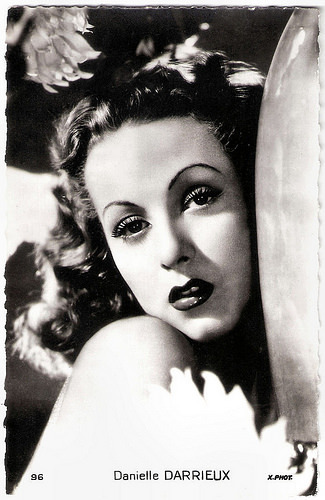
French postcard by Edition Chantal, Rueil, no. 96. Photo: x.phot.
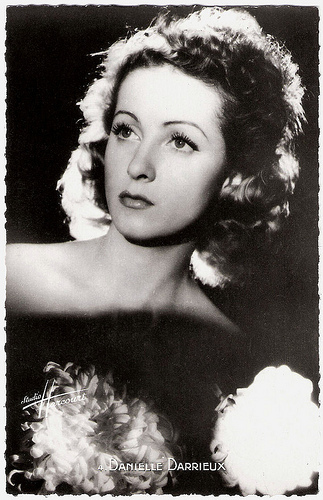
French postcard by S.E.R.P., Paris, no. 4. Photo: Studio Harcourt.
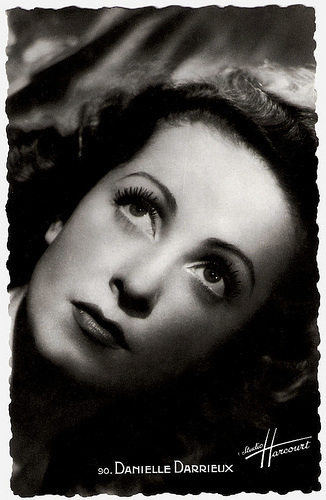
French postcard by SERP, Paris, no. 90. Photo: Studio Harcourt.
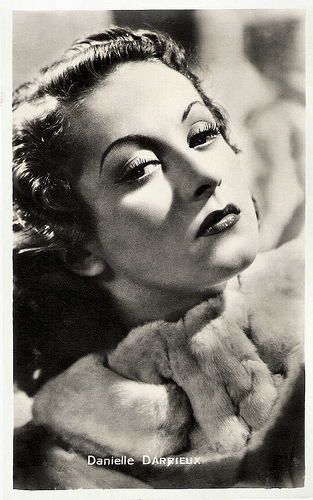
Dutch postcard.
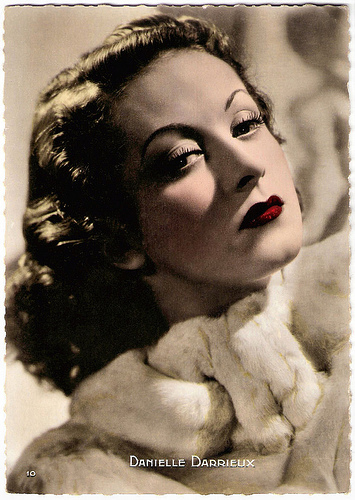
French postcard by Editions P.I., Paris, no. 10.
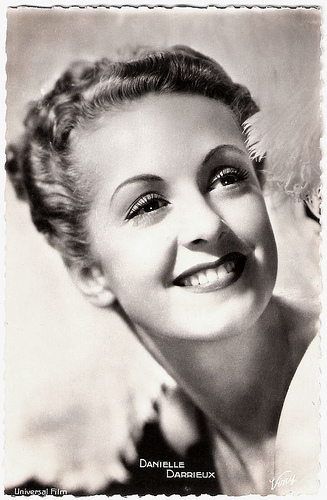
French postcard by Viny, no. 70. Photo: Universal Film.
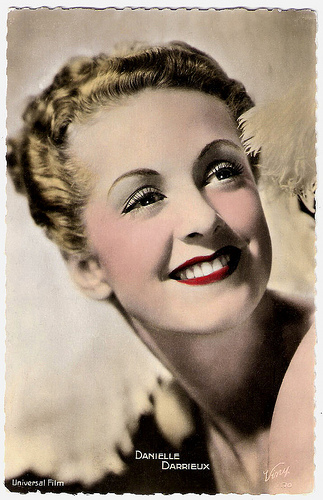
French postcard by Viny, no. 70. Photo: Universal Film.
Romantic Lead
Danielle Yvonne Marie Antoinette Darrieux was born in Bordeaux, France in 1917, but she was raised in Paris. She was the daughter of an army doctor who died when she was seven years old. Her brother was actor Olivier Darrieux.
Her family were keen music enthusiasts and Danielle studied the cello and piano at the Conservatoire de Musique (the Paris Conservatory). When she was only 14 she auditioned for a secondary role in the musical film Le Bal/The Ball (Wilhelm Thiele, 1931). Her beauty combined with her singing and dancing abilities got her the part.
Her performance as a headstrong teenager was impressive and the producer offered her a five-year contract. Her first romantic lead was in the backstage comedy La Crise est finie/The crisis is finished (Robert Siodmak, 1934) with Albert Préjean .
She scored an international hit with the historical love-drama Mayerling (Anatole Litvak, 1936) in which she played doomed Baroness Marie Vetsera opposite Charles Boyer as Archduke Rudolph of Austria.
In 1935, Darrieux married director/screenwriter Henri Decoin, and they made six films together in the following years like Abus de Confiance/Abused Confidence (Henri Decoin, 1938) with Charles Vanel . Decoin encouraged her to try Hollywood, and in 1938 she signed with studio executive Joe Pasternak from Universal Studios to appear in the comedy The Rage of Paris (Henry Koster, 1938) opposite Douglas Fairbanks, Jr.
Both the film and Darrieux were well-received, but her stay in Hollywood proved short-lived. She quickly returned to Paris, where she continued to star in such major hits as Battement de coeur/Beating Heart (Henri Decoin, 1940) with Claude Dauphin .
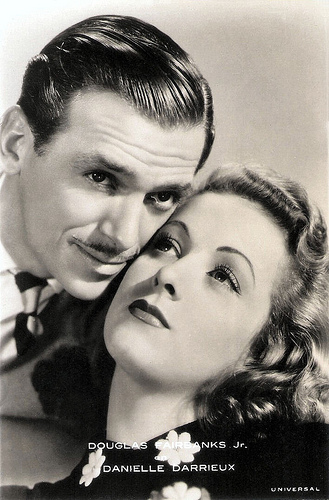
Dutch postcard by Sparo. Photo: Universal. Publicity still for The Rage of Paris (Henry Koster, 1938) with Douglas Fairbanks Jr.
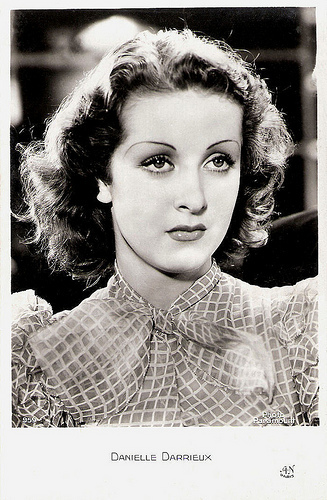
French postcard by A.N., Paris, no. 959. Photo: Paramount.
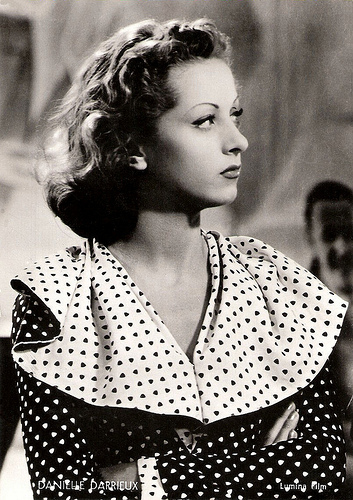
Dutch postcard by J.S.A. (J. Sleding, Amsterdam), no. 640/516. Photo: Lumina Film.
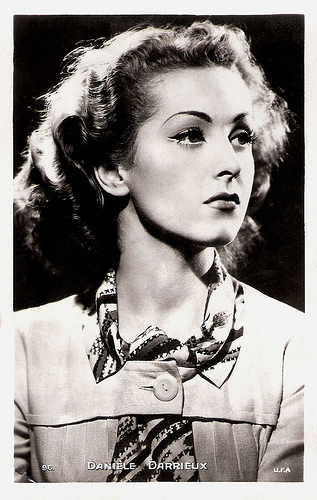
French postcard, no. 96. Photo: UFA.
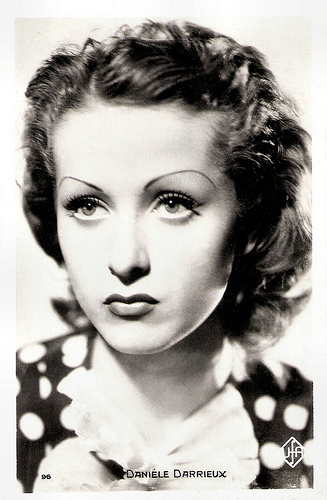
French postcard by Editions Chantal, no. 96. Photo: UFA.
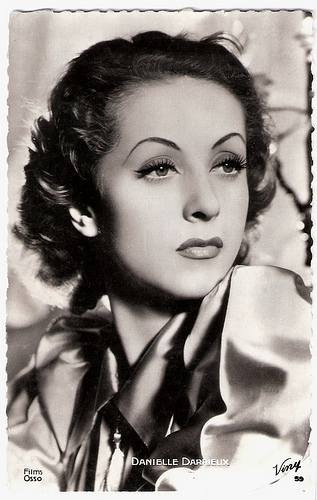
French postcard by Viny, no. 59. Photo: Films Osso.
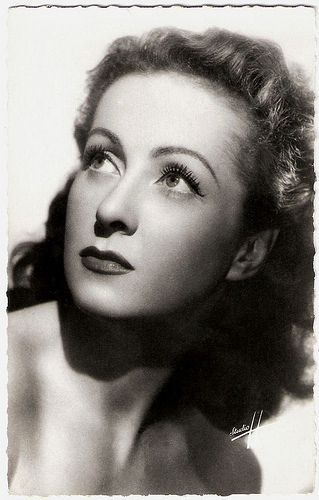
French postcard by Editions O.P., Paris, no. 1. Photo: Studio Harcourt.
German Occupation
After the occupation of France, Danielle Darrieux found herself working under the scrutiny of the new Nazi regime. She became the leading light of Continental, a Franco-German film company which was closely scrutinised by the Nazis. She distinguished herself in films such as Premier Rendez-Vous/Her First Affair (Henri Decoin, 1941).
After a visit to Germany, where she entertained the German troops, Darrieux’s popularity in France immediately plummeted and her name was placed on a death-list of the French Resistance. Even when her death sentence was lifted after the war, it was several years before she had regained her former popularity.
After the war, she explained that Alfred Greven, the manager of Continental, had threatened to deport her brother Olivier to Germany. After her divorce from Henri Decoin in 1941, she had married Dominican Republic diplomat and international jet-setter Porfirio Rubirosa in 1942. His anti-Nazi opinions resulted in his forced residence in Germany. Darrieux had accepted the promotional trip to Berlin in exchange for Rubirosa's liberation. They lived in Switzerland until the end of the war, and divorced in 1947.
A year later she married script-writer George Mitsikides and lived with him until his death in 1991. Her grand return came in 1949 with Claude Autant-Lara’s period farce Occupe-toi d'Amélie/Keep an Eye on Amelia (Claude Autant-Lara, 1949).
After La Ronde/Roundabout (Max Ophüls, 1950), Danielle Darrieux returned to Hollywood to appear as a French chanteuse in the MGM musical Rich, Young and Pretty (Norman Taurog, 1951) with Jane Powell. Joseph L. Mankiewicz then lured her to play the duplicitous lady friend of James Mason in the thriller 5 Fingers (Joseph L. Mankiewicz, 1952).
Back home, she starred in Le Plaisir/Pleasure (Max Ophüls, 1952) with Madeleine Renaud , and opposite Charles Boyer and Vittorio de Sica in Madame de....../Diamond Earrings (Max Ophüls, 1953).
James Travers at Films de France : "The 1950s saw a marked change in Darrieux on-screen persona. She was no longer the care-free ingenue of her pre-war years. She had become a sophisticated and passionate society woman, often appearing cold and calculating, but sometimes showing a tender tragic vulnerability. The film which defined Danielle Darrieux in this period was Madame de… (1953), in which she gave probably her best screen performance. This was the third of three films she appeared in which were directed by her fond admirer Max Ophüls."
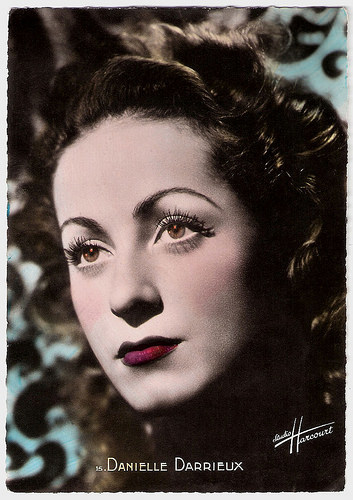
French postcard by S.E.R.P., Paris, no. 15. Photo: Studio Harcourt.
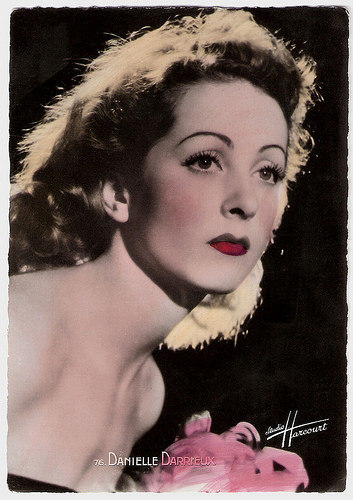
French postcard by S.E.R.P., Paris, no. 76. Photo: Studio Harcourt.
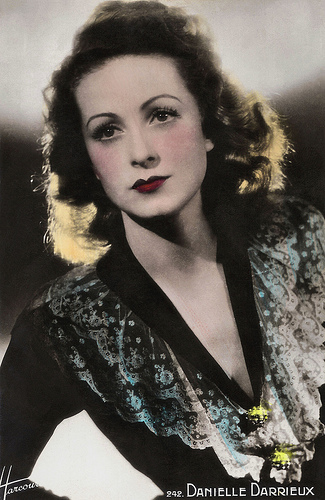
French postcard by S.E.R.P., Paris, no. 242. Photo: Studio Harcourt.
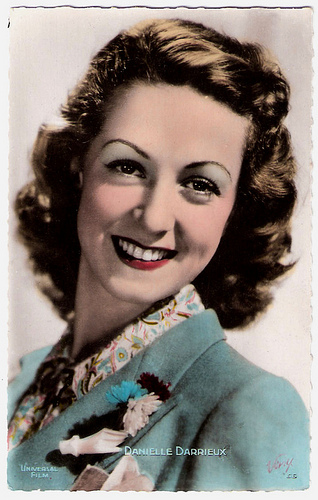
French postcard by Viny, no. 56. Photo: Universal Film.
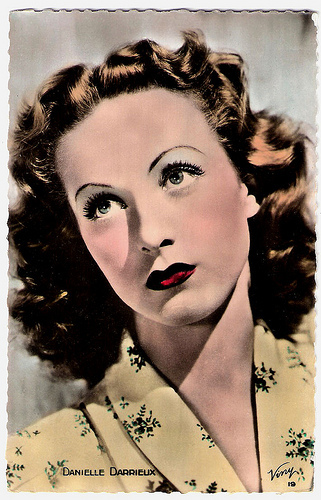
French postcard by Viny, no. 19.
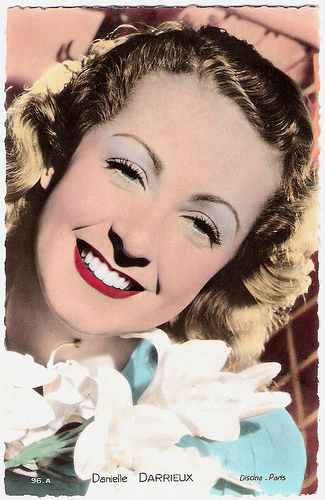
French postcard by Collection Chantal, Paris, no. 96 A. Photo: Discina, Paris.
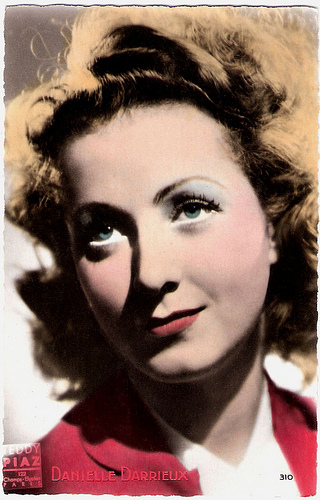
French postcard by Editions O.P., Paris, no. 310. Photo: Teddy Piaz, Paris.
Lady Chatterley's Lover
During the 1950s, Danielle Darrieux also appeared in Le rouge et le noir/The Red and the Black (Claude Autant-Lara, 1954) opposite Gérard Philipe , and in L’amant de Lady Chatterley/Lady Chatterley's Lover (Marc Allégret, 1955) with Leo Genn . Due to its content, the latter film was banned by the Catholic censors in the United States.
She also played a supporting role in United Artists' epic Alexander the Great (Robert Rossen, 1957) starring Richard Burton . It was her last Hollywood production. Since then she continued to work in the European cinema.
In England she starred opposite Kenneth More in The Greengage Summer (Lewis Gilbert, 1961), and in France she appeared as the mother of Catherine Deneuve in five films: L’Homme à femmes/Ladies Man (Jacques Gérard Cornu, 1960), the classic musical Les Demoiselles de Rochefort/The Young Girls of Rochefort (Jacques Demy, 1967), the drama Le Lieu du crime/Scene of the Crime (André Téchiné, 1986), the comedy-murder-mystery 8 femmes/8 Women (François Ozon, 2002), and in Persepolis (Marjane Satrapi, 2007). This remarkable animated feature is based on a graphic novel of the same name about the impact of the Iranian Islamic revolution on a girl's life as she grows to adulthood.
The actress sang in concerts and cabarets in the 1960s, and in 1970 replaced Katharine Hepburn in the Broadway musical Coco. In the 1980s, Danielle Darrieux scored a significant success in a Paris staging of the film musical Gigi.
For her long service to the motion picture industry, she was given an Honorary César Award in 1985. Her final film was Pièce montée/The Wedding Cake (Denys Granier-Deferre, 2010) with Jérémie Renier. D.B. DuMonteil at IMDb : "Pièce Montée (Tiered cake) is a funny comedy, with some nostalgia and an attack on the bourgeoisie Chabrol would not disown. Its depiction of a wedding in France is marvelously precise, with all these smug people, wearing their Sunday's best, and taking photographs of each other."
Madame Darrieux, rest in peace. Here at EFSP we salute you.
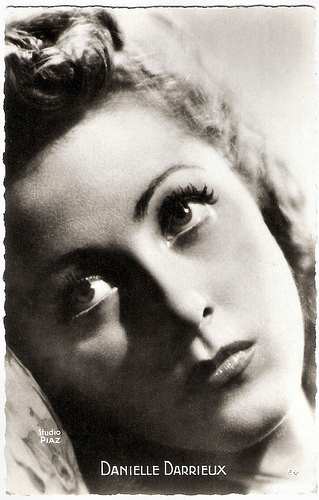
French postcard by Editions O.P., Paris, no. 54. Photo: Studio Piaz.
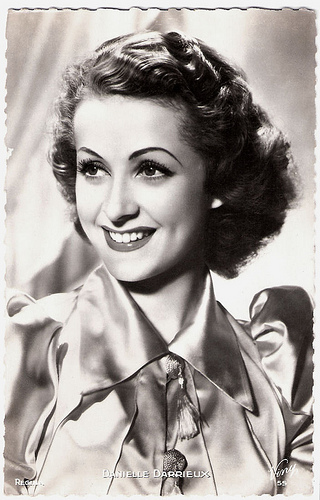
French postcard by Viny, no. 55. Photo: Regina.
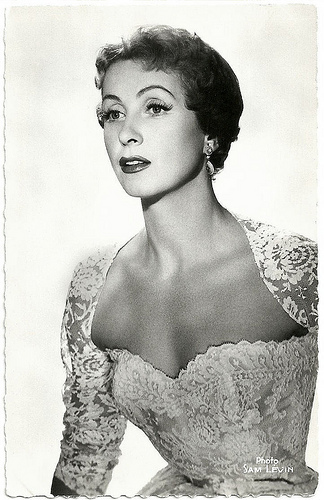
French postcard by Editions du Globe, Paris. Photo Sam Lévin.
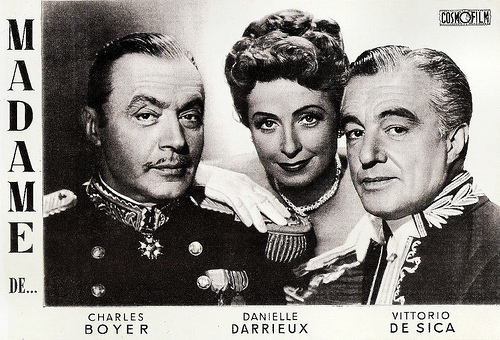
Spanish promotion card by Cosmofilm. Photo: publicity still for Madame de... (Max Ophüls, 1953) with Charles Boyer and Vittorio De Sica.
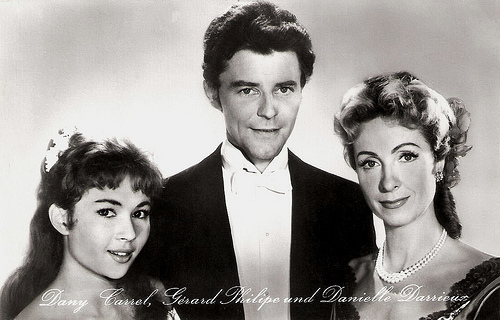
East-German postcard by VEB Progress Filmvertrieb, no. 1294, 1960. Photo: publicity still for Pot-Bouille/Lovers of Paris (Julien Duvivier, 1957) with Dany Carrel and Gérard Philipe.
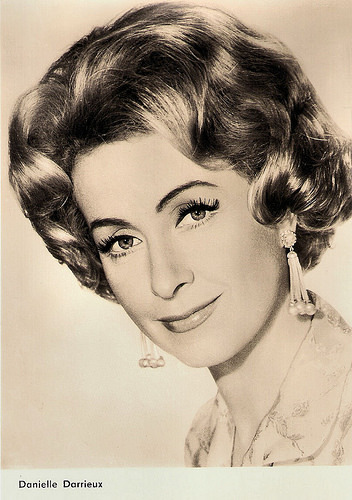
East-German postcard by VEB Progress Filmvertrieb, no. 2715, 1966.
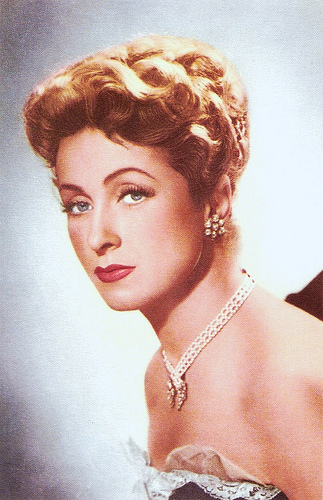
Vintage collectors card.
>
Scene from Madame De... (1953). Source: Classic Movies (YouTube).
Trailer of Les Demoiselles de Rochefort (1967). Source: British Film Institute (YouTube).
Trailer 8 femmes/8 Women (2002). Source: 2663KinkyCyborg (YouTube).
Sources: James Travers (Le Film Guide), Hal Erickson (All Movie), (IMDb), D.B. DuMonteil (IMDb), (TCM), AlloCiné (French), Wikipedia, and .

French postcard by Edition Chantal, Rueil, no. 96. Photo: x.phot.

French postcard by S.E.R.P., Paris, no. 4. Photo: Studio Harcourt.

French postcard by SERP, Paris, no. 90. Photo: Studio Harcourt.

Dutch postcard.

French postcard by Editions P.I., Paris, no. 10.

French postcard by Viny, no. 70. Photo: Universal Film.

French postcard by Viny, no. 70. Photo: Universal Film.
Romantic Lead
Danielle Yvonne Marie Antoinette Darrieux was born in Bordeaux, France in 1917, but she was raised in Paris. She was the daughter of an army doctor who died when she was seven years old. Her brother was actor Olivier Darrieux.
Her family were keen music enthusiasts and Danielle studied the cello and piano at the Conservatoire de Musique (the Paris Conservatory). When she was only 14 she auditioned for a secondary role in the musical film Le Bal/The Ball (Wilhelm Thiele, 1931). Her beauty combined with her singing and dancing abilities got her the part.
Her performance as a headstrong teenager was impressive and the producer offered her a five-year contract. Her first romantic lead was in the backstage comedy La Crise est finie/The crisis is finished (Robert Siodmak, 1934) with Albert Préjean .
She scored an international hit with the historical love-drama Mayerling (Anatole Litvak, 1936) in which she played doomed Baroness Marie Vetsera opposite Charles Boyer as Archduke Rudolph of Austria.
In 1935, Darrieux married director/screenwriter Henri Decoin, and they made six films together in the following years like Abus de Confiance/Abused Confidence (Henri Decoin, 1938) with Charles Vanel . Decoin encouraged her to try Hollywood, and in 1938 she signed with studio executive Joe Pasternak from Universal Studios to appear in the comedy The Rage of Paris (Henry Koster, 1938) opposite Douglas Fairbanks, Jr.
Both the film and Darrieux were well-received, but her stay in Hollywood proved short-lived. She quickly returned to Paris, where she continued to star in such major hits as Battement de coeur/Beating Heart (Henri Decoin, 1940) with Claude Dauphin .

Dutch postcard by Sparo. Photo: Universal. Publicity still for The Rage of Paris (Henry Koster, 1938) with Douglas Fairbanks Jr.

French postcard by A.N., Paris, no. 959. Photo: Paramount.

Dutch postcard by J.S.A. (J. Sleding, Amsterdam), no. 640/516. Photo: Lumina Film.

French postcard, no. 96. Photo: UFA.

French postcard by Editions Chantal, no. 96. Photo: UFA.

French postcard by Viny, no. 59. Photo: Films Osso.

French postcard by Editions O.P., Paris, no. 1. Photo: Studio Harcourt.
German Occupation
After the occupation of France, Danielle Darrieux found herself working under the scrutiny of the new Nazi regime. She became the leading light of Continental, a Franco-German film company which was closely scrutinised by the Nazis. She distinguished herself in films such as Premier Rendez-Vous/Her First Affair (Henri Decoin, 1941).
After a visit to Germany, where she entertained the German troops, Darrieux’s popularity in France immediately plummeted and her name was placed on a death-list of the French Resistance. Even when her death sentence was lifted after the war, it was several years before she had regained her former popularity.
After the war, she explained that Alfred Greven, the manager of Continental, had threatened to deport her brother Olivier to Germany. After her divorce from Henri Decoin in 1941, she had married Dominican Republic diplomat and international jet-setter Porfirio Rubirosa in 1942. His anti-Nazi opinions resulted in his forced residence in Germany. Darrieux had accepted the promotional trip to Berlin in exchange for Rubirosa's liberation. They lived in Switzerland until the end of the war, and divorced in 1947.
A year later she married script-writer George Mitsikides and lived with him until his death in 1991. Her grand return came in 1949 with Claude Autant-Lara’s period farce Occupe-toi d'Amélie/Keep an Eye on Amelia (Claude Autant-Lara, 1949).
After La Ronde/Roundabout (Max Ophüls, 1950), Danielle Darrieux returned to Hollywood to appear as a French chanteuse in the MGM musical Rich, Young and Pretty (Norman Taurog, 1951) with Jane Powell. Joseph L. Mankiewicz then lured her to play the duplicitous lady friend of James Mason in the thriller 5 Fingers (Joseph L. Mankiewicz, 1952).
Back home, she starred in Le Plaisir/Pleasure (Max Ophüls, 1952) with Madeleine Renaud , and opposite Charles Boyer and Vittorio de Sica in Madame de....../Diamond Earrings (Max Ophüls, 1953).
James Travers at Films de France : "The 1950s saw a marked change in Darrieux on-screen persona. She was no longer the care-free ingenue of her pre-war years. She had become a sophisticated and passionate society woman, often appearing cold and calculating, but sometimes showing a tender tragic vulnerability. The film which defined Danielle Darrieux in this period was Madame de… (1953), in which she gave probably her best screen performance. This was the third of three films she appeared in which were directed by her fond admirer Max Ophüls."

French postcard by S.E.R.P., Paris, no. 15. Photo: Studio Harcourt.

French postcard by S.E.R.P., Paris, no. 76. Photo: Studio Harcourt.

French postcard by S.E.R.P., Paris, no. 242. Photo: Studio Harcourt.

French postcard by Viny, no. 56. Photo: Universal Film.

French postcard by Viny, no. 19.

French postcard by Collection Chantal, Paris, no. 96 A. Photo: Discina, Paris.

French postcard by Editions O.P., Paris, no. 310. Photo: Teddy Piaz, Paris.
Lady Chatterley's Lover
During the 1950s, Danielle Darrieux also appeared in Le rouge et le noir/The Red and the Black (Claude Autant-Lara, 1954) opposite Gérard Philipe , and in L’amant de Lady Chatterley/Lady Chatterley's Lover (Marc Allégret, 1955) with Leo Genn . Due to its content, the latter film was banned by the Catholic censors in the United States.
She also played a supporting role in United Artists' epic Alexander the Great (Robert Rossen, 1957) starring Richard Burton . It was her last Hollywood production. Since then she continued to work in the European cinema.
In England she starred opposite Kenneth More in The Greengage Summer (Lewis Gilbert, 1961), and in France she appeared as the mother of Catherine Deneuve in five films: L’Homme à femmes/Ladies Man (Jacques Gérard Cornu, 1960), the classic musical Les Demoiselles de Rochefort/The Young Girls of Rochefort (Jacques Demy, 1967), the drama Le Lieu du crime/Scene of the Crime (André Téchiné, 1986), the comedy-murder-mystery 8 femmes/8 Women (François Ozon, 2002), and in Persepolis (Marjane Satrapi, 2007). This remarkable animated feature is based on a graphic novel of the same name about the impact of the Iranian Islamic revolution on a girl's life as she grows to adulthood.
The actress sang in concerts and cabarets in the 1960s, and in 1970 replaced Katharine Hepburn in the Broadway musical Coco. In the 1980s, Danielle Darrieux scored a significant success in a Paris staging of the film musical Gigi.
For her long service to the motion picture industry, she was given an Honorary César Award in 1985. Her final film was Pièce montée/The Wedding Cake (Denys Granier-Deferre, 2010) with Jérémie Renier. D.B. DuMonteil at IMDb : "Pièce Montée (Tiered cake) is a funny comedy, with some nostalgia and an attack on the bourgeoisie Chabrol would not disown. Its depiction of a wedding in France is marvelously precise, with all these smug people, wearing their Sunday's best, and taking photographs of each other."
Madame Darrieux, rest in peace. Here at EFSP we salute you.

French postcard by Editions O.P., Paris, no. 54. Photo: Studio Piaz.

French postcard by Viny, no. 55. Photo: Regina.

French postcard by Editions du Globe, Paris. Photo Sam Lévin.

Spanish promotion card by Cosmofilm. Photo: publicity still for Madame de... (Max Ophüls, 1953) with Charles Boyer and Vittorio De Sica.

East-German postcard by VEB Progress Filmvertrieb, no. 1294, 1960. Photo: publicity still for Pot-Bouille/Lovers of Paris (Julien Duvivier, 1957) with Dany Carrel and Gérard Philipe.

East-German postcard by VEB Progress Filmvertrieb, no. 2715, 1966.

Vintage collectors card.
>
Scene from Madame De... (1953). Source: Classic Movies (YouTube).
Trailer of Les Demoiselles de Rochefort (1967). Source: British Film Institute (YouTube).
Trailer 8 femmes/8 Women (2002). Source: 2663KinkyCyborg (YouTube).
Sources: James Travers (Le Film Guide), Hal Erickson (All Movie), (IMDb), D.B. DuMonteil (IMDb), (TCM), AlloCiné (French), Wikipedia, and .
Published on October 19, 2017 22:00
October 18, 2017
Mata Hari (1931)
Earlier this week, the Fries Museum in Leeuwarden opened its exhibition on exotic dancer and executed spy Mata Hari (1876-1917). From the local newspapers in Friesland to the New York Times, all critics were positive in their reviews. EFSP updates an earlier post on the Leeuwarden-born 'red dancer' who was an international society figure between 1905 and the First World War. EFSP contributor Ivo Blom is one of the researchers for the exhibition. About his research he wrote two fascinating articles on his personal blog, of which we post two excerpts in combination with postcards from the classic Hollywood biopic Mata Hari (George Fitzmaurice, 1931) starring Greta Garbo and Ramon Novarro.
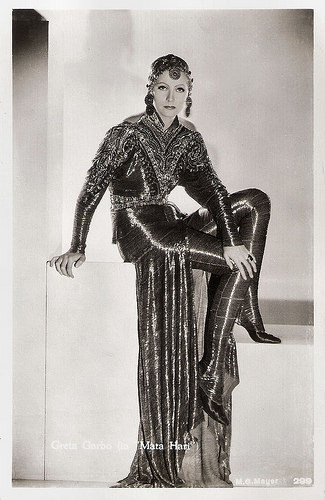
Dutch postcard by JosPe, no. 299. Photo: Clarence Sinclair Bull / Metro-Goldwyn-Mayer. Publicity still for Mata Hari (George Fitzmaurice, 1931).
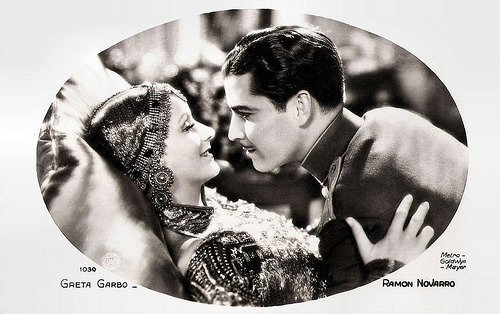
French postcard by EDUG, no. 1030. Photo: Metro-Goldwyn-Mayer / Clarence Sinclair Bull. Publicity still for Mata Hari (George Fitzmaurice, 1931) with Greta Garbo and Ramon Novarro .
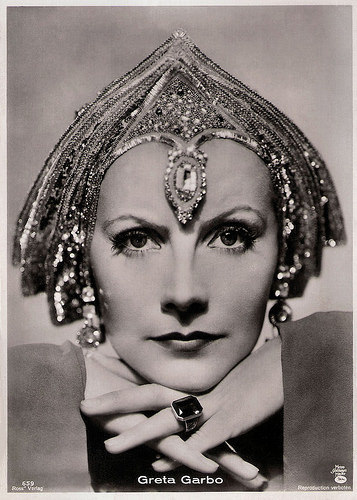
German postcard by Ross Verlag, no. 659. Photo: Metro-Goldwyn-Mayer / Clarence Sinclair Bull. Publicity still for Mata Hari (George Fitzmaurice, 1931) with Greta Garbo .
Researching a clip of a fashionable lady
Ivo Blom: "Still materials of Mata Hari are abundant: gorgeous coloured postcards, studio photos by prominents such as Emilio Sommariva, actuality photos etc., but what lacked were moving images. With a woman who was such a society figure between 1905 and the First World War, one asks himself why Pathé, Gaumont or any other prominent company did not film this woman, whose oriental dances had caused such a stir in Paris and beyond, and who was the mistress of many a prominent figure in politics, finance and culture?
Thus in films on her life or compilation films on the First World War a clip persisted of a fashionable lady helped in her coat by a doorman. She afterwards steps into a luxurious car with chauffeur and is driven away. This clip, coined as being with Mata Hari, has been used over and again as real footage with Mata Hari.
Even the respectable site EFG1914, supported and replenished by various European Film Archives, including the Dutch EYE, holds a compilation film that contains the same clip. It may be well have been the original culprit of the massive reuse and mythologization of ‘real’ film footage with Mata Hari. The compilation film uploaded by LUCE is the Italian version of 14-18 (1963) by French filmmaker Jean Aurel. The commentary states we notice Mata Hari here, helped into a taxi. The image quality was too poor to recognize any person. So where did Aurel did take it from? Could I get a better image quality?
Researching this clip was quite an adventure. I first contacted the CNC (Centre National pour la Cinématographie) near Paris, where Béatrice Paste kindly indicated me the compilation 14-18 by Aurel was a Gaumont production and CNC had recently digitized the film. Paste advised me to contact the Cinémathèque Gaumont. So I contacted curator Manuela Padoan who referred me to Nathalie Sitko, who proved to be an avid documentalist and helpful researcher.
In the meantime I searched myself on the site of Pathé-Gaumont-Archives. There I found the compilation documentary Paris après 3 ans de guerre (1917) by Gaumont, which contained the same clip, but now without any indication of Mata Hari. The description on the Gaumont site just said: ”Au pied d’un escalier, une femme élégante (bourgeoise) enfile son manteau aidé d’un maître d’hôtel, elle attend son véhicule et monte dans l’automobile.”
The film had been uploaded in HD, so the image quality was really good. Still, I had my doubts whether this was really the famous Mata Hari. My doubts proved to be right. Read on at Ivo Blom's blog."
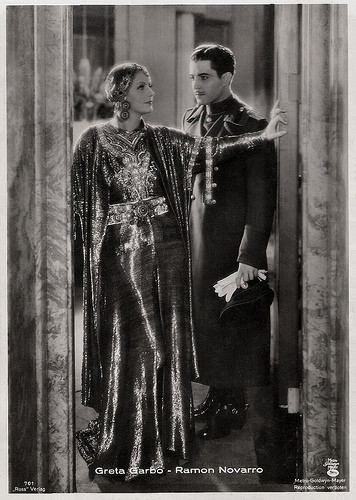
German postcard by Ross Verlag, no. 701. Photo: Metro-Goldwyn-Mayer / Clarence Sinclair Bull. Publicity still for Mata Hari (George Fitzmaurice, 1931).
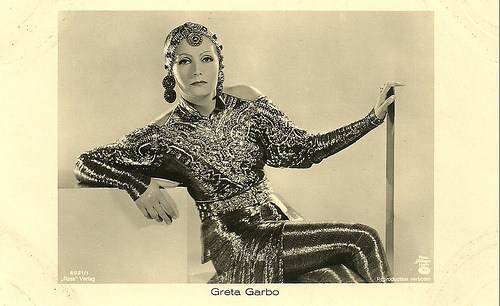
German postcard by Ross Verlag, no. 6521/1, 1931-1932. Photo: MGM. Greta Garbo in Mata Hari (George Fitzmaurice, 1931).
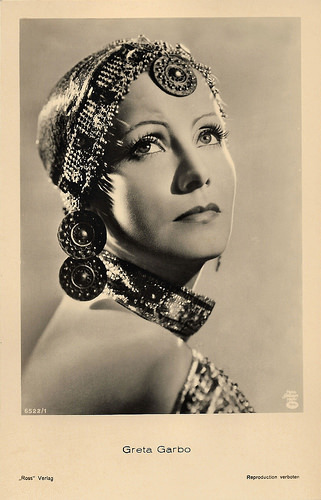
German postcard by Ross Verlag, no. 6522/1, 1931-1932. Photo: Clarence Sinclair Bull / Metro-Goldwyn-Mayer. Publicity still for Mata Hari (George Fitzmaurice, 1931).
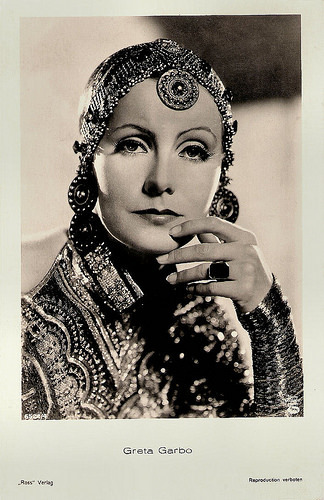
German postcard by Ross Verlag, no. 6522/4, 1931-1932. Photo: Metro-Goldwyn-Mayer / Clarence Sinclair Bull. Publicity still for Mata Hari (George Fitzmaurice, 1931).
Asta Nielsen and the Copy Cats
Ivo Blom: "In many analogue and digital sources a film entitled Mata Hari/Die Spionin (Ludwig Wolf, 1920/1921), starring Asta Nielsen , is listed as the oldest biopic of the life of Mata Hari aka Lady MacLeod aka Margaretha Zelle. You will find this on the Internet Movie Database (IMDb), which in general for German silent cinema is quite unreliable.
But one also traces it in the English and Dutch Wikipedia , James Monaco’s The Movie Guide, David Thompson’s The New Biographical Dictionary of Film, James Robert Parish’s Prostitution in Hollywood films, Jerry Vermilye’s More films from the thirties, Georg Seeßlen’s Filmwissen: Thriller: Grundlagen des populären Films and several earlier publications by the same author, Léon Schirmann’s Mata-Hari: autopsie d’une machination, Michael R. Pitts’s The Great Spies Pictures, Valeria Palumbo’s Le figlie di Lilith: vipere, dive, dark ladies e femmes fatales : l’altra ribellione femminile, Rüdiger Dirk and Claudius Sowa’s Paris im Film: Filmografie einer Stadt, and many others. The English Wikipedia even indicates Mata Hari (1920) and Die Spionin (1921) as two separate films, both about Mata Hari.
Nevertheless, my suspicions arose when I could not find the film on the generally quite thorough German films site www.filmportal.de. When I launched a call for more information on the Facebook site of Domitor, the network for researchers dealing with early cinema, my suspicions increased.
Joseph Juenger, Artistic Director at Stummfilm-Festival Karlsruhe, asked if I was really sure about this film. He could‘t find a film with the title Die Spionin, neither on the FIAF-CD nor in the 2010 two-volume extensive monography on Asta Nielsen by Heide Schlüpmann and Karola Gramann, nor on filmportal.de. Juenger remarked there was only a film with the title Die Rache der Spionin (1921), but the director was Richard Eicherg and Nielsen lacked.
I therefore contacted Asta Nielsen expert Heide Schlüpmann, who kindly told me despite her thorough research she never found a film with Nielsen called either Mata Hari or Die Spionin. It just seemed that all the above mentioned authors had just copied each other without bothering to check any original sources." Read on at Ivo Blom's blog.
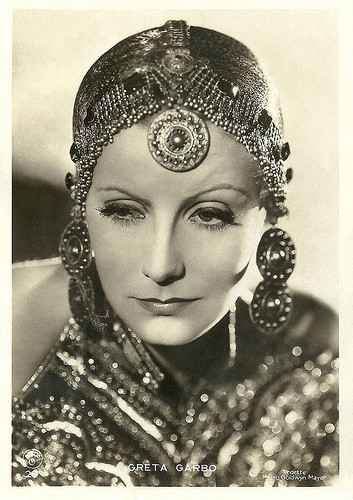
French postcard by Europe, no. 20. Photo: Metro-Goldwyn-Mayer / Clarence Sinclair Bull. Publicity still for Mata Hari (George Fitzmaurice, 1931).
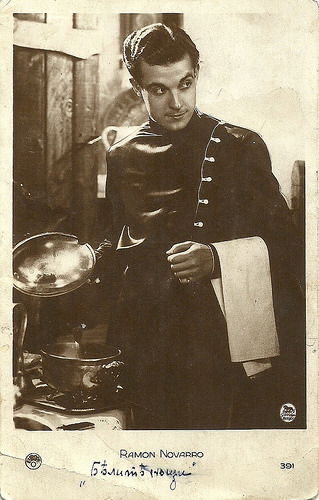
French postcard by Europe, no. 391. Photo: Metro-Goldwyn-Mayer / Clarence Sinclair Bull. Ramon Novarro as Lt. Alexis Rosanoff in Mata Hari (George Fitzmaurice, 1931).
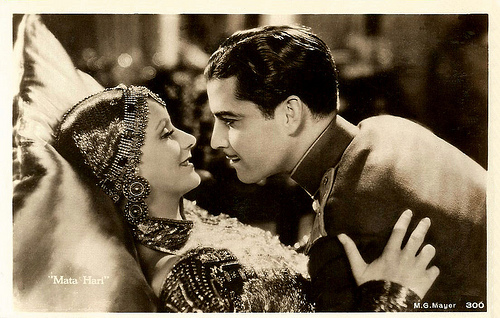
Dutch postcard, no. 300. Photo: Metro-Goldwyn-Mayer / Clarence Sinclair Bull. Publicity still for Mata Hari (George Fitzmaurice, 1931) with Greta Garbo and Ramon Novarro .
Thanks Ivo, for the permission to copy-cat your posts!

Dutch postcard by JosPe, no. 299. Photo: Clarence Sinclair Bull / Metro-Goldwyn-Mayer. Publicity still for Mata Hari (George Fitzmaurice, 1931).

French postcard by EDUG, no. 1030. Photo: Metro-Goldwyn-Mayer / Clarence Sinclair Bull. Publicity still for Mata Hari (George Fitzmaurice, 1931) with Greta Garbo and Ramon Novarro .

German postcard by Ross Verlag, no. 659. Photo: Metro-Goldwyn-Mayer / Clarence Sinclair Bull. Publicity still for Mata Hari (George Fitzmaurice, 1931) with Greta Garbo .
Researching a clip of a fashionable lady
Ivo Blom: "Still materials of Mata Hari are abundant: gorgeous coloured postcards, studio photos by prominents such as Emilio Sommariva, actuality photos etc., but what lacked were moving images. With a woman who was such a society figure between 1905 and the First World War, one asks himself why Pathé, Gaumont or any other prominent company did not film this woman, whose oriental dances had caused such a stir in Paris and beyond, and who was the mistress of many a prominent figure in politics, finance and culture?
Thus in films on her life or compilation films on the First World War a clip persisted of a fashionable lady helped in her coat by a doorman. She afterwards steps into a luxurious car with chauffeur and is driven away. This clip, coined as being with Mata Hari, has been used over and again as real footage with Mata Hari.
Even the respectable site EFG1914, supported and replenished by various European Film Archives, including the Dutch EYE, holds a compilation film that contains the same clip. It may be well have been the original culprit of the massive reuse and mythologization of ‘real’ film footage with Mata Hari. The compilation film uploaded by LUCE is the Italian version of 14-18 (1963) by French filmmaker Jean Aurel. The commentary states we notice Mata Hari here, helped into a taxi. The image quality was too poor to recognize any person. So where did Aurel did take it from? Could I get a better image quality?
Researching this clip was quite an adventure. I first contacted the CNC (Centre National pour la Cinématographie) near Paris, where Béatrice Paste kindly indicated me the compilation 14-18 by Aurel was a Gaumont production and CNC had recently digitized the film. Paste advised me to contact the Cinémathèque Gaumont. So I contacted curator Manuela Padoan who referred me to Nathalie Sitko, who proved to be an avid documentalist and helpful researcher.
In the meantime I searched myself on the site of Pathé-Gaumont-Archives. There I found the compilation documentary Paris après 3 ans de guerre (1917) by Gaumont, which contained the same clip, but now without any indication of Mata Hari. The description on the Gaumont site just said: ”Au pied d’un escalier, une femme élégante (bourgeoise) enfile son manteau aidé d’un maître d’hôtel, elle attend son véhicule et monte dans l’automobile.”
The film had been uploaded in HD, so the image quality was really good. Still, I had my doubts whether this was really the famous Mata Hari. My doubts proved to be right. Read on at Ivo Blom's blog."

German postcard by Ross Verlag, no. 701. Photo: Metro-Goldwyn-Mayer / Clarence Sinclair Bull. Publicity still for Mata Hari (George Fitzmaurice, 1931).

German postcard by Ross Verlag, no. 6521/1, 1931-1932. Photo: MGM. Greta Garbo in Mata Hari (George Fitzmaurice, 1931).

German postcard by Ross Verlag, no. 6522/1, 1931-1932. Photo: Clarence Sinclair Bull / Metro-Goldwyn-Mayer. Publicity still for Mata Hari (George Fitzmaurice, 1931).

German postcard by Ross Verlag, no. 6522/4, 1931-1932. Photo: Metro-Goldwyn-Mayer / Clarence Sinclair Bull. Publicity still for Mata Hari (George Fitzmaurice, 1931).
Asta Nielsen and the Copy Cats
Ivo Blom: "In many analogue and digital sources a film entitled Mata Hari/Die Spionin (Ludwig Wolf, 1920/1921), starring Asta Nielsen , is listed as the oldest biopic of the life of Mata Hari aka Lady MacLeod aka Margaretha Zelle. You will find this on the Internet Movie Database (IMDb), which in general for German silent cinema is quite unreliable.
But one also traces it in the English and Dutch Wikipedia , James Monaco’s The Movie Guide, David Thompson’s The New Biographical Dictionary of Film, James Robert Parish’s Prostitution in Hollywood films, Jerry Vermilye’s More films from the thirties, Georg Seeßlen’s Filmwissen: Thriller: Grundlagen des populären Films and several earlier publications by the same author, Léon Schirmann’s Mata-Hari: autopsie d’une machination, Michael R. Pitts’s The Great Spies Pictures, Valeria Palumbo’s Le figlie di Lilith: vipere, dive, dark ladies e femmes fatales : l’altra ribellione femminile, Rüdiger Dirk and Claudius Sowa’s Paris im Film: Filmografie einer Stadt, and many others. The English Wikipedia even indicates Mata Hari (1920) and Die Spionin (1921) as two separate films, both about Mata Hari.
Nevertheless, my suspicions arose when I could not find the film on the generally quite thorough German films site www.filmportal.de. When I launched a call for more information on the Facebook site of Domitor, the network for researchers dealing with early cinema, my suspicions increased.
Joseph Juenger, Artistic Director at Stummfilm-Festival Karlsruhe, asked if I was really sure about this film. He could‘t find a film with the title Die Spionin, neither on the FIAF-CD nor in the 2010 two-volume extensive monography on Asta Nielsen by Heide Schlüpmann and Karola Gramann, nor on filmportal.de. Juenger remarked there was only a film with the title Die Rache der Spionin (1921), but the director was Richard Eicherg and Nielsen lacked.
I therefore contacted Asta Nielsen expert Heide Schlüpmann, who kindly told me despite her thorough research she never found a film with Nielsen called either Mata Hari or Die Spionin. It just seemed that all the above mentioned authors had just copied each other without bothering to check any original sources." Read on at Ivo Blom's blog.

French postcard by Europe, no. 20. Photo: Metro-Goldwyn-Mayer / Clarence Sinclair Bull. Publicity still for Mata Hari (George Fitzmaurice, 1931).

French postcard by Europe, no. 391. Photo: Metro-Goldwyn-Mayer / Clarence Sinclair Bull. Ramon Novarro as Lt. Alexis Rosanoff in Mata Hari (George Fitzmaurice, 1931).

Dutch postcard, no. 300. Photo: Metro-Goldwyn-Mayer / Clarence Sinclair Bull. Publicity still for Mata Hari (George Fitzmaurice, 1931) with Greta Garbo and Ramon Novarro .
Thanks Ivo, for the permission to copy-cat your posts!
Published on October 18, 2017 22:00
October 17, 2017
Feodor Chaliapin
Russian opera singer Feodor Chaliapin (1873–1938) was an international sensation and is considered as the greatest Russian singer of the twentieth century, as well as the greatest male operatic actor ever. The possessor of a large, deep and expressive basso profundo, he was celebrated at major opera houses all over the world and established the tradition of naturalistic acting in operas. The only sound film which shows his acting style is Don Quixote (Georg Wilhelm Pabst, 1933).
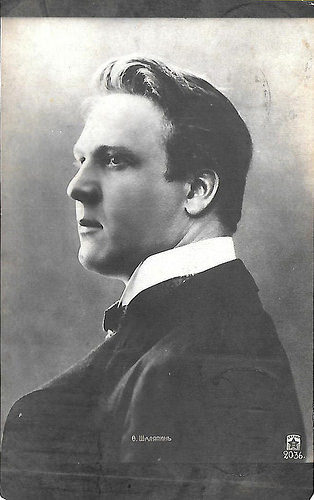
Russian postcard, no. 2036. Collection: Didier Hanson.
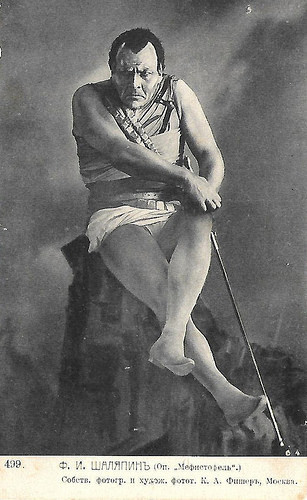
Russian postcard, no. 499. Photo: K. Fisher. Publicity still for the stage production of Arrigo Boito's opera Mefistofele. He sang the title role on the occasion of his first appearance outside Russia at La Scala, Milan in 1901 and also on his North American debut at the Metropolitan Opera, New York, in 1907. Collection: Didier Hanson.
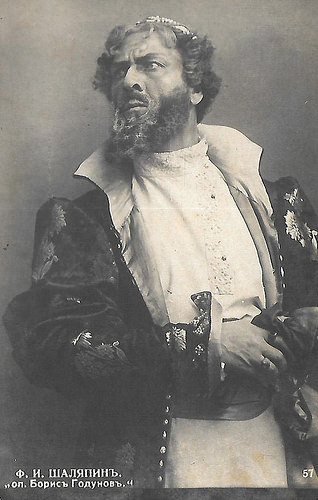
Russian postcard, no. 57. Photo: publicity still for the stage production of Modest Mussorgsky's opera Boris Godunov. Collection: Didier Hanson.
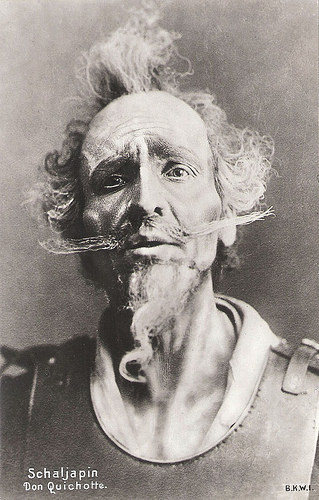
Feodor Chaliapin as Don Quixote. German postcard by B.K.W.I.
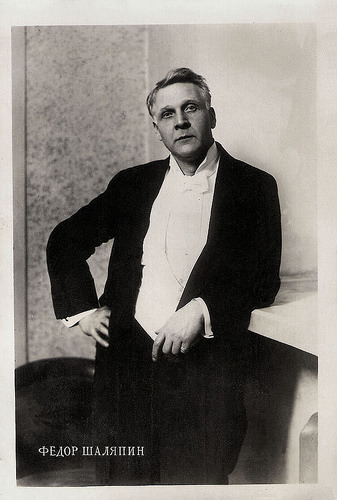
Russian postcard by Dynamo, no. MB 22975-86, 1954.
His approach revolutionised acting in opera
Feodor Ivanovich Chaliapin (Russian: Фёдор Ива́нович Шаля́пин, or Fyodor Ivanovich Shalyapin) was born in 1873, into a poor peasant family in Omet Tawi, near Kazan, Russia. His childhood was full of suffering, hunger, and humiliation. From the age of 10, he worked as an apprentice to a shoemaker, a sales clerk, a carpenter, and a lowly clerk in a district court before joining, at age 17, a local operetta company.
In 1890, Chaliapin was hired to sing in a choir at the Semenov-Samarsky private theatre in Ufa. There he began singing solo parts. In 1891, he toured Russia with the Dergach Opera. In 1892, he settled in Tiflis (now Tbilisi, Georgia), because he found a good teacher, Dmitri Usatov, who gave Chaliapin free professional opera training for one year. He also sang at the St. Aleksandr Nevsky Cathedral in Tbilisi. In 1893, he began his career at the Tbilisi Opera, and a year later, he moved to Moscow upon recommendation of Dmitri Usatov.
In 1895 ,Chaliapin debuted at the Imperial Mariinsky Theatre as Mephistopheles in Charles Gounod’s Faust, in which he was a considerable success. In 1896 he also joined Mamontovs Private Russian Opera in Moscow, where he mastered the Russian, French, and Italian roles that made him famous. Savva Mamontov was a Russian industrialist and philanthropist, who staged the operas, conducted the orchestra, trained the actors, taught them singing and paid all the expenses. At Mamontov's, he met in 1897 Sergei Rachmaninoff, who started as an assistant conductor there. The two men remained friends for life.
With Rachmaninoff he learned the title role of Modest Mussorgsky's Boris Godunov, which became his signature character. Rachmaninoff taught him much about musicianship, including how to analyse a music score, and insisted that Chaliapin learn not only his own roles but also all the other roles in the operas in which he was scheduled to appear. When Chaliapin became dissatisfied with his performances, Chaliapin began to attend straight dramatic plays to learn the art of acting. His approach revolutionised acting in opera.
In 1896, Savva Mamontov introduced Chaliapin to a young Italian ballerina Iola Tornagi, who came to Moscow for a stage career. She quit dancing and devoted herself to family life with Chaliapin. He was very happy in this marriage. From 1899 until 1914, he also performed regularly at the Bolshoi Theatre in Moscow. The couple settled in Moscow and had six children. Their first boy died at the age of 4, causing Chaliapin a nervous breakdown.
In 1901, Chaliapin made his sensational debut at La Scala in the role of the devil in Mefistofele by Arrigo Boito under the baton of conductor Arturo Toscanini. Other famous roles were Boris Godunov in Mussorgsky's opera, King Philip in Giuseppe Verdi's Don Carlos., Bertram in Giacomo Meyerbeer's Robert le Diable, and Ivan the Terrible in The Maid of Pskov by Nikolai Rimsky-Korsakov. His great comic characterizations were Don Basilio in Gioachino Rossini’s Il barbiere di Siviglia and Leporello in Wolfgang Amadeus Mozart’s Don Giovanni.
In 1906, Chaliapin started a civil union with Maria Valentinovna Petzhold in St. Petersburg, Russia. She had three daughters with Chaliapin in addition to 2 other children from her previous family. He could not legalize his second family, because his first wife would not give him a divorce. Chaliapin even applied to the Emperor Tsar Nicholas II with a request of registering his three daughters under his last name. His request was not satisfied.
In 1913, Chaliapin was introduced to London and Paris by the brilliant entrepreneur Sergei Diaghilev. He began giving well-received solo recitals in Paris in which he sang traditional Russian folk songs as well as more serious fare, and also performed at the Paris Opera. His acting and singing was sensational to the western audiences. He made many sound recordings, of which the 1913 recordings of the Russian folk songs Vdol po Piterskoi and The Song of the Volga Boatmen are best known.
In 1915, he made his film debut as Czar Ivan IV the Terrible in the silent Russian film Tsar Ivan Vasilevich Groznyy/Czar Ivan the Terrible (Aleksandr Ivanov-Gai, 1915) opposite the later director Richard Boleslawski. Fourteen years later, he appeared in another silent film, the German-Czech coproduction Aufruhr des Blutes/Riot of the blood (Victor Trivas, 1929) with Vera Voronina and Oscar Marion .
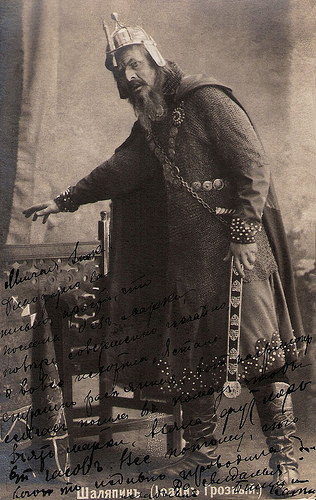
Feodor Chaliapin as as Czar Ivan the Terrible. Russian postcard, sent by mail in 1905.
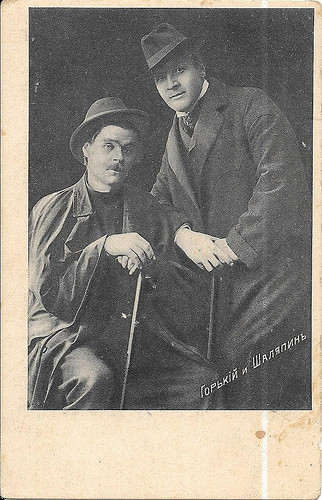
Maxim Gorky and Feodor Chaliapin. Russian postcard. Collection: Didier Hanson. Chaliapin collaborated with Gorky, who wrote and edited his memoirs, which he published in 1933. They broke after the publication.
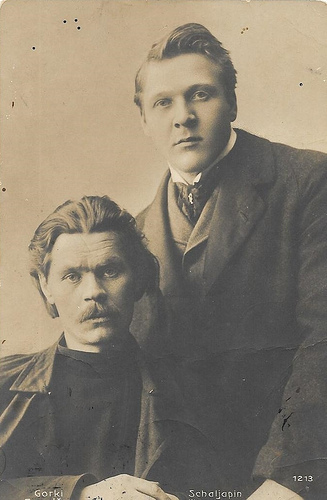
Maxim Gorky and Feodor Chaliapin. Russian postcard, no. 1213. Collection: Didier Hanson.
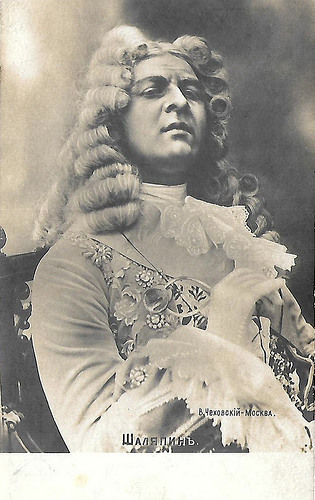
Feodor Chaliapin. Russian postcard. Collection: Didier Hanson.
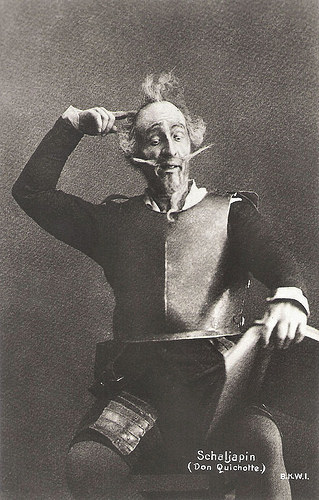
Feodor Chaliapin as Don Quixote. German postcard by B.K.W.I.
The undisputed best basso in the first half of the 20th century
Feodor Chaliapin was torn between his two families for many years, living with one in Moscow, and with another in St. Petersburg. With Maria Petzhold and their three daughters, he left Russia in 1922 as part of an extended tour of western Europe. They would never return. The family settled in Paris. A man of lower-class origins, Chaliapin was not unsympathetic to the Bolshevik Revolution and his emigration from Russia was painful. Although he had left Russia for good, he remained a tax-paying citizen of Soviet Russia for several years. Finally he could divorce in 1927 and marry Maria Petzhold.
Chaliapin worked for impresario Sol Hurok and from 1921 on, he sang for eight seasons at the Metropolitan Opera in New York. His debut at the Met in the 1907 season had been disappointing due to the unprecedented frankness of his stage acting. In 1921, the public in New York had grown more broad-minded and the eight seasons were a huge success. According to Steve Shelokhonov at IMDb , Chaliapin was the undisputed best basso in the first half of the 20th century. He had revolutionised opera by bringing serious acting in combination with great singing.
His first open break with the Soviet regime occurred in 1927 when the government, as part of its campaign to pressure him into returning to Russia, stripped him of his title of 'The First People’s Artist of the Soviet Republic' and threatened to deprive him of Soviet citizenship. Prodded by Joseph Stalin, Chaliapin’s longtime friend Maxim Gorky tried to persuade him to return to Russia. Gorky broke with him after Chaliapin published his memoirs, Man and Mask: Forty Years in the Life of a Singer (Maska i dusha, 1932), in which he denounced the lack of freedom under the Bolsheviks.
The only sound film which shows Chaliapin's acting style is Don Quixote/Adventures of Don Quixote (Georg Wilhelm Pabst, 1933). He had also starred onstage as the knight in Jules Massenet's 1910 opera, Don Quichotte, but the 1933 film does not use Massenet's music, and is more faithful to Miguel de Cervantes' novel than the opera. In fact there were three versions of this early sound film. Georg Wilhelm Pabst shot simultaneously with the German language version also English and French versions. Feodor Chaliapin Sr. starred in all three versions of Don Quixote, but with a different supporting cast. Sancho Pansa was played by Dorville in the German and French versions but by George Robey in the English version.
Benoit A. Racine at IMDb : "These films (the French, English and German versions) were an attempt to capture his legendary stage performance of this character even though the songs are by Jacques Ibert. Ravel had also been asked to compose the songs for the film but he missed the deadline and his songs survive on their own with texts that are different from those found here. The interplay between the French and English versions is fascinating. Some scenes are done exactly the same for better or worse, some use the same footage, re-cut to edit out performance problems, while others have slight variants in staging and dialogue. (The English version was doctored by Australian-born scriptwriter and director John Farrow, Mia's father, by the way.) Even though the films are short and they transform, reduce and simplify considerably the original novel, they still manage to carry the themes and the feeling that would make Man of La Mancha a hit several decades later and to be evocative of Cervantes' Spain."
In the late 1930s, Feodor Chaliapin Sr. suffered from leukaemia and kidney ailment. In 1937, he died in Paris, France. He was laid to rest is the Novodevichy Monastery Cemetery in Moscow. Chaliapin was awarded a Star on the Hollywood Walk of Fame for Recording at 6770 Hollywood Boulevard in Hollywood, California. In 1998, the TV film Chaliapin: The Enchanter (Elisabeth Kapnist, 1998) followed.
His son Boris Chaliapin became a famous painter. who painted the portraits used on 414 covers of the Time magazine between 1942 and 1970. Another son Feodor Chaliapin Jr. became a film actor, who appeared in character roles in such films as the Western Buffalo Bill, l'eroe del far west/Buffalo Bill (Mario Costa, 1965) with Gordon Scott, and Der Name der Rose/The Name of the Rose (Jean-Jacques Annaud, 1986), starring Sean Connery . His first wife, Iola Tornagi, lived in the Soviet Union until 1959, when Nikita Khrushchev brought the 'Thaw'. Tornagi was allowed to leave the Soviet Union and reunited with her son Feodor Chaliapin Jr, in Rome, Italy.
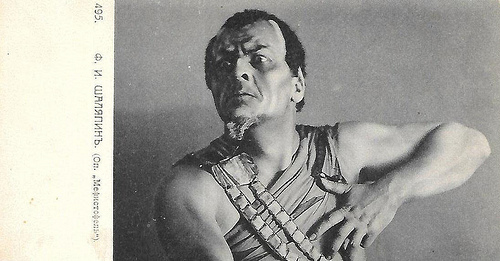
Russian postcard, no. 495. Photo: K. Fisher. Publicity still for the stage production of Arrigo Boito's opera Mefistofele. Collection: Didier Hanson.
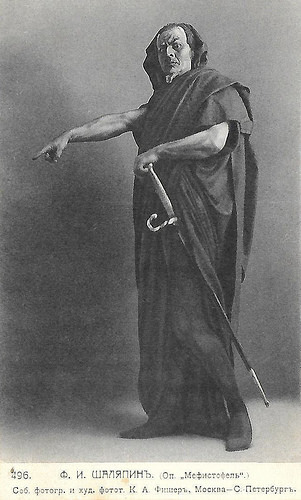
Russian postcard, no. 496. Photo: K. Fisher. Publicity still for the stage production of Arrigo Boito's opera Mefistofele. Collection: Didier Hanson.
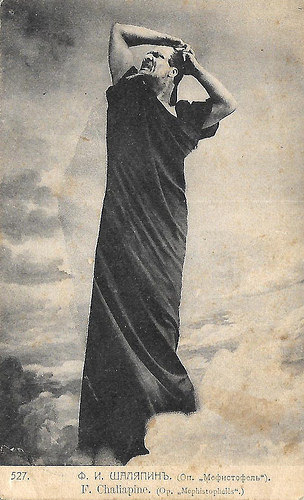
Russian postcard, no. 499. Photo: K. Fisher. Publicity still for the stage production of Arrigo Boito's opera Mefistofele. Collection: Didier Hanson.
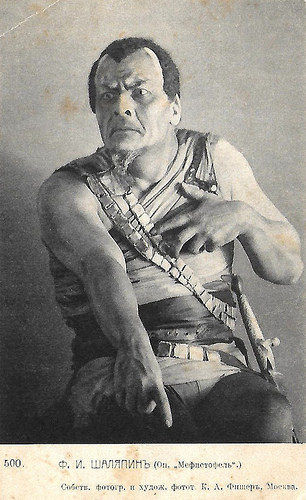
Russian postcard, no. 500. Photo: K. Fisher. Publicity still for the stage production of Arrigo Boito's opera Mefistofele. Collection: Didier Hanson.
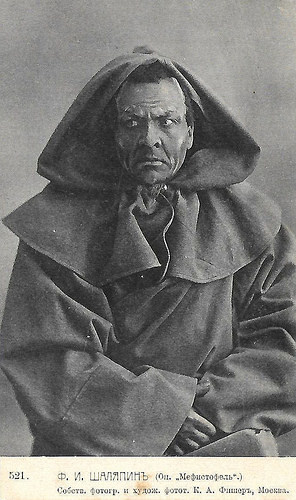
Russian postcard, no. 521. Photo: K. Fisher. Publicity still for the stage production of Arrigo Boito's opera Mefistofele. Collection: Didier Hanson.
Don Quichote/Adventures of Don Quixote (1933). Source: LikeManyThingThings (YouTube).
Sources: (IMDb), Benoit A. Racine (IMDb), Encyclopaedia Britannica, Wikipedia and .

Russian postcard, no. 2036. Collection: Didier Hanson.

Russian postcard, no. 499. Photo: K. Fisher. Publicity still for the stage production of Arrigo Boito's opera Mefistofele. He sang the title role on the occasion of his first appearance outside Russia at La Scala, Milan in 1901 and also on his North American debut at the Metropolitan Opera, New York, in 1907. Collection: Didier Hanson.

Russian postcard, no. 57. Photo: publicity still for the stage production of Modest Mussorgsky's opera Boris Godunov. Collection: Didier Hanson.

Feodor Chaliapin as Don Quixote. German postcard by B.K.W.I.

Russian postcard by Dynamo, no. MB 22975-86, 1954.
His approach revolutionised acting in opera
Feodor Ivanovich Chaliapin (Russian: Фёдор Ива́нович Шаля́пин, or Fyodor Ivanovich Shalyapin) was born in 1873, into a poor peasant family in Omet Tawi, near Kazan, Russia. His childhood was full of suffering, hunger, and humiliation. From the age of 10, he worked as an apprentice to a shoemaker, a sales clerk, a carpenter, and a lowly clerk in a district court before joining, at age 17, a local operetta company.
In 1890, Chaliapin was hired to sing in a choir at the Semenov-Samarsky private theatre in Ufa. There he began singing solo parts. In 1891, he toured Russia with the Dergach Opera. In 1892, he settled in Tiflis (now Tbilisi, Georgia), because he found a good teacher, Dmitri Usatov, who gave Chaliapin free professional opera training for one year. He also sang at the St. Aleksandr Nevsky Cathedral in Tbilisi. In 1893, he began his career at the Tbilisi Opera, and a year later, he moved to Moscow upon recommendation of Dmitri Usatov.
In 1895 ,Chaliapin debuted at the Imperial Mariinsky Theatre as Mephistopheles in Charles Gounod’s Faust, in which he was a considerable success. In 1896 he also joined Mamontovs Private Russian Opera in Moscow, where he mastered the Russian, French, and Italian roles that made him famous. Savva Mamontov was a Russian industrialist and philanthropist, who staged the operas, conducted the orchestra, trained the actors, taught them singing and paid all the expenses. At Mamontov's, he met in 1897 Sergei Rachmaninoff, who started as an assistant conductor there. The two men remained friends for life.
With Rachmaninoff he learned the title role of Modest Mussorgsky's Boris Godunov, which became his signature character. Rachmaninoff taught him much about musicianship, including how to analyse a music score, and insisted that Chaliapin learn not only his own roles but also all the other roles in the operas in which he was scheduled to appear. When Chaliapin became dissatisfied with his performances, Chaliapin began to attend straight dramatic plays to learn the art of acting. His approach revolutionised acting in opera.
In 1896, Savva Mamontov introduced Chaliapin to a young Italian ballerina Iola Tornagi, who came to Moscow for a stage career. She quit dancing and devoted herself to family life with Chaliapin. He was very happy in this marriage. From 1899 until 1914, he also performed regularly at the Bolshoi Theatre in Moscow. The couple settled in Moscow and had six children. Their first boy died at the age of 4, causing Chaliapin a nervous breakdown.
In 1901, Chaliapin made his sensational debut at La Scala in the role of the devil in Mefistofele by Arrigo Boito under the baton of conductor Arturo Toscanini. Other famous roles were Boris Godunov in Mussorgsky's opera, King Philip in Giuseppe Verdi's Don Carlos., Bertram in Giacomo Meyerbeer's Robert le Diable, and Ivan the Terrible in The Maid of Pskov by Nikolai Rimsky-Korsakov. His great comic characterizations were Don Basilio in Gioachino Rossini’s Il barbiere di Siviglia and Leporello in Wolfgang Amadeus Mozart’s Don Giovanni.
In 1906, Chaliapin started a civil union with Maria Valentinovna Petzhold in St. Petersburg, Russia. She had three daughters with Chaliapin in addition to 2 other children from her previous family. He could not legalize his second family, because his first wife would not give him a divorce. Chaliapin even applied to the Emperor Tsar Nicholas II with a request of registering his three daughters under his last name. His request was not satisfied.
In 1913, Chaliapin was introduced to London and Paris by the brilliant entrepreneur Sergei Diaghilev. He began giving well-received solo recitals in Paris in which he sang traditional Russian folk songs as well as more serious fare, and also performed at the Paris Opera. His acting and singing was sensational to the western audiences. He made many sound recordings, of which the 1913 recordings of the Russian folk songs Vdol po Piterskoi and The Song of the Volga Boatmen are best known.
In 1915, he made his film debut as Czar Ivan IV the Terrible in the silent Russian film Tsar Ivan Vasilevich Groznyy/Czar Ivan the Terrible (Aleksandr Ivanov-Gai, 1915) opposite the later director Richard Boleslawski. Fourteen years later, he appeared in another silent film, the German-Czech coproduction Aufruhr des Blutes/Riot of the blood (Victor Trivas, 1929) with Vera Voronina and Oscar Marion .

Feodor Chaliapin as as Czar Ivan the Terrible. Russian postcard, sent by mail in 1905.

Maxim Gorky and Feodor Chaliapin. Russian postcard. Collection: Didier Hanson. Chaliapin collaborated with Gorky, who wrote and edited his memoirs, which he published in 1933. They broke after the publication.

Maxim Gorky and Feodor Chaliapin. Russian postcard, no. 1213. Collection: Didier Hanson.

Feodor Chaliapin. Russian postcard. Collection: Didier Hanson.

Feodor Chaliapin as Don Quixote. German postcard by B.K.W.I.
The undisputed best basso in the first half of the 20th century
Feodor Chaliapin was torn between his two families for many years, living with one in Moscow, and with another in St. Petersburg. With Maria Petzhold and their three daughters, he left Russia in 1922 as part of an extended tour of western Europe. They would never return. The family settled in Paris. A man of lower-class origins, Chaliapin was not unsympathetic to the Bolshevik Revolution and his emigration from Russia was painful. Although he had left Russia for good, he remained a tax-paying citizen of Soviet Russia for several years. Finally he could divorce in 1927 and marry Maria Petzhold.
Chaliapin worked for impresario Sol Hurok and from 1921 on, he sang for eight seasons at the Metropolitan Opera in New York. His debut at the Met in the 1907 season had been disappointing due to the unprecedented frankness of his stage acting. In 1921, the public in New York had grown more broad-minded and the eight seasons were a huge success. According to Steve Shelokhonov at IMDb , Chaliapin was the undisputed best basso in the first half of the 20th century. He had revolutionised opera by bringing serious acting in combination with great singing.
His first open break with the Soviet regime occurred in 1927 when the government, as part of its campaign to pressure him into returning to Russia, stripped him of his title of 'The First People’s Artist of the Soviet Republic' and threatened to deprive him of Soviet citizenship. Prodded by Joseph Stalin, Chaliapin’s longtime friend Maxim Gorky tried to persuade him to return to Russia. Gorky broke with him after Chaliapin published his memoirs, Man and Mask: Forty Years in the Life of a Singer (Maska i dusha, 1932), in which he denounced the lack of freedom under the Bolsheviks.
The only sound film which shows Chaliapin's acting style is Don Quixote/Adventures of Don Quixote (Georg Wilhelm Pabst, 1933). He had also starred onstage as the knight in Jules Massenet's 1910 opera, Don Quichotte, but the 1933 film does not use Massenet's music, and is more faithful to Miguel de Cervantes' novel than the opera. In fact there were three versions of this early sound film. Georg Wilhelm Pabst shot simultaneously with the German language version also English and French versions. Feodor Chaliapin Sr. starred in all three versions of Don Quixote, but with a different supporting cast. Sancho Pansa was played by Dorville in the German and French versions but by George Robey in the English version.
Benoit A. Racine at IMDb : "These films (the French, English and German versions) were an attempt to capture his legendary stage performance of this character even though the songs are by Jacques Ibert. Ravel had also been asked to compose the songs for the film but he missed the deadline and his songs survive on their own with texts that are different from those found here. The interplay between the French and English versions is fascinating. Some scenes are done exactly the same for better or worse, some use the same footage, re-cut to edit out performance problems, while others have slight variants in staging and dialogue. (The English version was doctored by Australian-born scriptwriter and director John Farrow, Mia's father, by the way.) Even though the films are short and they transform, reduce and simplify considerably the original novel, they still manage to carry the themes and the feeling that would make Man of La Mancha a hit several decades later and to be evocative of Cervantes' Spain."
In the late 1930s, Feodor Chaliapin Sr. suffered from leukaemia and kidney ailment. In 1937, he died in Paris, France. He was laid to rest is the Novodevichy Monastery Cemetery in Moscow. Chaliapin was awarded a Star on the Hollywood Walk of Fame for Recording at 6770 Hollywood Boulevard in Hollywood, California. In 1998, the TV film Chaliapin: The Enchanter (Elisabeth Kapnist, 1998) followed.
His son Boris Chaliapin became a famous painter. who painted the portraits used on 414 covers of the Time magazine between 1942 and 1970. Another son Feodor Chaliapin Jr. became a film actor, who appeared in character roles in such films as the Western Buffalo Bill, l'eroe del far west/Buffalo Bill (Mario Costa, 1965) with Gordon Scott, and Der Name der Rose/The Name of the Rose (Jean-Jacques Annaud, 1986), starring Sean Connery . His first wife, Iola Tornagi, lived in the Soviet Union until 1959, when Nikita Khrushchev brought the 'Thaw'. Tornagi was allowed to leave the Soviet Union and reunited with her son Feodor Chaliapin Jr, in Rome, Italy.

Russian postcard, no. 495. Photo: K. Fisher. Publicity still for the stage production of Arrigo Boito's opera Mefistofele. Collection: Didier Hanson.

Russian postcard, no. 496. Photo: K. Fisher. Publicity still for the stage production of Arrigo Boito's opera Mefistofele. Collection: Didier Hanson.

Russian postcard, no. 499. Photo: K. Fisher. Publicity still for the stage production of Arrigo Boito's opera Mefistofele. Collection: Didier Hanson.

Russian postcard, no. 500. Photo: K. Fisher. Publicity still for the stage production of Arrigo Boito's opera Mefistofele. Collection: Didier Hanson.

Russian postcard, no. 521. Photo: K. Fisher. Publicity still for the stage production of Arrigo Boito's opera Mefistofele. Collection: Didier Hanson.
Don Quichote/Adventures of Don Quixote (1933). Source: LikeManyThingThings (YouTube).
Sources: (IMDb), Benoit A. Racine (IMDb), Encyclopaedia Britannica, Wikipedia and .
Published on October 17, 2017 22:00
October 16, 2017
Andrée Brabant
Andrée Brabant (1901-1989) was a charming French film actress whose career peaked in the silent era of French cinema. She was discovered by Abel Gance and also worked with such major directors as André Antoine, Germaine Dulac and Julien Duvivier.
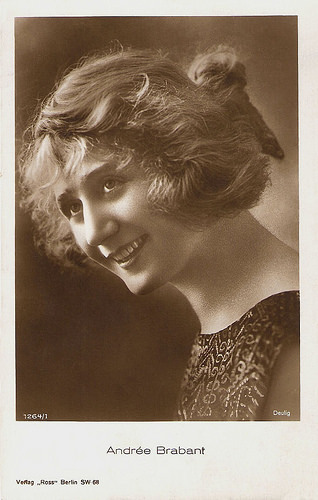
German postcard by Ross Verlag, no. 1264/1, 1927-1928. Photo: Deulig.
Charming New Dancer
Marie Thérèse Andrée Brabant was born in Reims, France, in 1901. Shortly after her birth, she was placed in the custody of her grandmother before returning at the age of four to her father, a railway employee, and her mother, a housewife. Ten years later, after an infidelity of his father, her parents separated.
She followed her mother to Paris where she quickly found work as shorthand-typist. Shortly afterwards, Andrée met the ballet master of the Mayol concerts and was engaged by Félix Mayol himself to be a dancer in his revues.
In 1916 film director Abel Gance was looking for a young artist for his next film, Le Droit à la vie/The Right to Life (Abel Gance, 1916), when one of his friends advised him to go and see the new dancer at Mayol’s. The filmmaker fell for her charm and he immediately offered her the female lead role opposite Paul Vermoyal and Léon Mathot .
Andrée Brabant left the stage to fully devote herself to cinema. The following year Abel Gance used her again as the protagonist in La zone de la mort/The Zone of Death (Abel Gance, 1917), again with Léon Mathot. She also acted in André Antoine’s Les travailleurs de la mer/Workers of the Sea (1917), adapted from Victor Hugo and starring Romuald Joubé .
For twelve years, the beautiful young actress, still chaperoned by her mother, performed in about twenty productions that would make her a real star. Her best films include La cigarette/Cigarette (Germaine Dulac, 1919), La maison vide/The Empty House (Raymond Bernard 1921), and Le rêve/The Dream (Jacques de Baroncelli, 1921), an adaptation of Emile Zola.
In La cigarette/Cigarette (Germaine Dulac, 1919), Andrée Brabant played the wife of a museum director ( Gabriel Signoret ) who suspects his wife of infidelity and places a poisoned cigarette in the box on his desk, allowing fate to strike.
In La maison vide/The Empty House (Raymond Bernard 1921), she is a young typist hired by an old entomologist (Henri Debain), who is fascinated with her, while two industrialists (Pierre Alcover, Jacques Roussel) try to conquer her. She instead favours a young clerk, so her employer is left alone in his empty house.
In Le rêve/The Dream (Jacques de Baroncelli, 1921) she is a foundling gathered under a porch of a cathedral. As an adult, she suffers from a bishop ( Gabriel Signoret ) who opposes his son’s marriage with her. When he finally consents she dies during her wedding at the place where she was found.
Andrée Brabant also appeared in two serials of quality, Travail/Work (1919) by Henri Pouctal and Tao, le fantôme noir/Tao, the black ghost (Gaston Ravel, 1923), starring Joë Hamman .
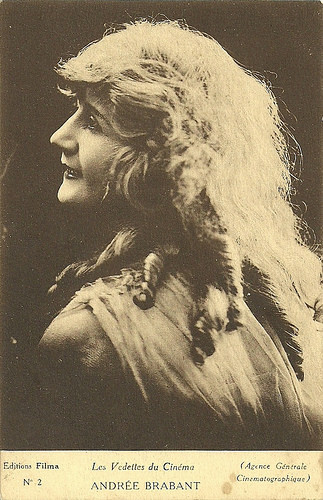
French postcard by Editions Filma in Les Vedettes du Cinéma series, no. 2. Photo: Agence Générale Cinématographique.
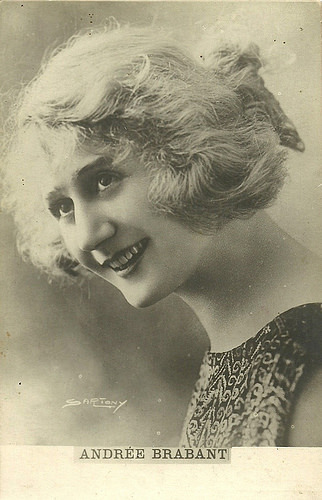
French (?) postcard. Photo: Sartony.
A sumptuous life
Andrée Brabant starred in Les ombres qui passent/The Shadows That Pass (Alexandre Volkoff, 1924) opposite the great Russian actor Ivan Mozzhukhin with whom she had a brief liaison. She plays the wife of Mozzhukhin who is caught in a net of swindlers led by femme fatale Nathalie Lissenko .
Brabant also starred in Le mariage de Mademoiselle Beulemans/The Marriage of Mademoiselle Beulemans (1927), one of the very first films of Julien Duvivier. In this romantic comedy, based on a classic play by Jean François Fonson and Fernand Wicheler, she is a Belgian brewer’s daughter who is betrothed to a local ( René Lefevre ), but loves a Parisian classy man (Jean Dehelly). Then the daughter finds out her fiancé secretly already has a wife and kid.
At that time, Andrée Brabant led a sumptuous life, bought a mansion in Neuilly-sur-Seine, which was soon called the Hotel Brabant, and accumulated amorous adventures, some of them illustrious, e.g. with King Fouad 1er Of Egypt and the President of the Republic Paul Deschanel. She never married and never had a child, a sacrifice for her career that she would accept without regret for the rest of her life.
In 1929, Brabant played in her first sound film, Maternité/Maternity by Jean Benoît-Lévy, but she made the mistake of believing that this new Art was not made for her.
The star honoured the few film contracts in progress, such as the excellent silent drama Au bonheur des dames (Julien Duvivier, 1929) with Dita Parlo. Then she left the film industry to play comedy at the Grand-Guignol theater to prove to her audience that she did not need cinema to know how to speak.
But, with the arrival of sound film, competition became rough and the salaries less and less. When she tried to return to the cinema, she only found a few small parts, such as in Le feu de paille/Hay Fever (Jean Benoît-Lévy, 1939), starring Lucien Baroux and Orane Demazis.
Andrée separated herself little by little from all of her jewellery, then from all her possessions, including her mansion. Nevertheless, she remained active at the Grand Guignol until the end of the Second World War.
After the Liberation, Andrée Brabant went to live with her mother in Marseille. After the death of the latter and without resources, she became a demonstrator in household appliances for Brandt and travelled for her job all over France and North Africa. At the age of retirement, she settled in Belgentier in the Var region.
In 1964 Jean-Christophe Averty made for his TV documentary series Trente ans de silence one episode with and on Brabant. In 1964, she also played her last film role in L'âge ingrat/The Ungrateful Age (Gilles Grangier, 1964) with Fernandel and Jean Gabin , after which the old actress inexorably sank into oblivion.
Andrée Brabant died in 1989 in Toulon, France, in total anonymity. She was 88. All in all, she had acted in some 35 films.
Scenes from Au bonheur des dames (Julien Duvivier, 1929) with Dita Parlo. Source: Radio Santos (YouTube).
Sources: Pascal Donald (CineArtistes), Unifrance, Wikipedia (French and English) and .

German postcard by Ross Verlag, no. 1264/1, 1927-1928. Photo: Deulig.
Charming New Dancer
Marie Thérèse Andrée Brabant was born in Reims, France, in 1901. Shortly after her birth, she was placed in the custody of her grandmother before returning at the age of four to her father, a railway employee, and her mother, a housewife. Ten years later, after an infidelity of his father, her parents separated.
She followed her mother to Paris where she quickly found work as shorthand-typist. Shortly afterwards, Andrée met the ballet master of the Mayol concerts and was engaged by Félix Mayol himself to be a dancer in his revues.
In 1916 film director Abel Gance was looking for a young artist for his next film, Le Droit à la vie/The Right to Life (Abel Gance, 1916), when one of his friends advised him to go and see the new dancer at Mayol’s. The filmmaker fell for her charm and he immediately offered her the female lead role opposite Paul Vermoyal and Léon Mathot .
Andrée Brabant left the stage to fully devote herself to cinema. The following year Abel Gance used her again as the protagonist in La zone de la mort/The Zone of Death (Abel Gance, 1917), again with Léon Mathot. She also acted in André Antoine’s Les travailleurs de la mer/Workers of the Sea (1917), adapted from Victor Hugo and starring Romuald Joubé .
For twelve years, the beautiful young actress, still chaperoned by her mother, performed in about twenty productions that would make her a real star. Her best films include La cigarette/Cigarette (Germaine Dulac, 1919), La maison vide/The Empty House (Raymond Bernard 1921), and Le rêve/The Dream (Jacques de Baroncelli, 1921), an adaptation of Emile Zola.
In La cigarette/Cigarette (Germaine Dulac, 1919), Andrée Brabant played the wife of a museum director ( Gabriel Signoret ) who suspects his wife of infidelity and places a poisoned cigarette in the box on his desk, allowing fate to strike.
In La maison vide/The Empty House (Raymond Bernard 1921), she is a young typist hired by an old entomologist (Henri Debain), who is fascinated with her, while two industrialists (Pierre Alcover, Jacques Roussel) try to conquer her. She instead favours a young clerk, so her employer is left alone in his empty house.
In Le rêve/The Dream (Jacques de Baroncelli, 1921) she is a foundling gathered under a porch of a cathedral. As an adult, she suffers from a bishop ( Gabriel Signoret ) who opposes his son’s marriage with her. When he finally consents she dies during her wedding at the place where she was found.
Andrée Brabant also appeared in two serials of quality, Travail/Work (1919) by Henri Pouctal and Tao, le fantôme noir/Tao, the black ghost (Gaston Ravel, 1923), starring Joë Hamman .

French postcard by Editions Filma in Les Vedettes du Cinéma series, no. 2. Photo: Agence Générale Cinématographique.

French (?) postcard. Photo: Sartony.
A sumptuous life
Andrée Brabant starred in Les ombres qui passent/The Shadows That Pass (Alexandre Volkoff, 1924) opposite the great Russian actor Ivan Mozzhukhin with whom she had a brief liaison. She plays the wife of Mozzhukhin who is caught in a net of swindlers led by femme fatale Nathalie Lissenko .
Brabant also starred in Le mariage de Mademoiselle Beulemans/The Marriage of Mademoiselle Beulemans (1927), one of the very first films of Julien Duvivier. In this romantic comedy, based on a classic play by Jean François Fonson and Fernand Wicheler, she is a Belgian brewer’s daughter who is betrothed to a local ( René Lefevre ), but loves a Parisian classy man (Jean Dehelly). Then the daughter finds out her fiancé secretly already has a wife and kid.
At that time, Andrée Brabant led a sumptuous life, bought a mansion in Neuilly-sur-Seine, which was soon called the Hotel Brabant, and accumulated amorous adventures, some of them illustrious, e.g. with King Fouad 1er Of Egypt and the President of the Republic Paul Deschanel. She never married and never had a child, a sacrifice for her career that she would accept without regret for the rest of her life.
In 1929, Brabant played in her first sound film, Maternité/Maternity by Jean Benoît-Lévy, but she made the mistake of believing that this new Art was not made for her.
The star honoured the few film contracts in progress, such as the excellent silent drama Au bonheur des dames (Julien Duvivier, 1929) with Dita Parlo. Then she left the film industry to play comedy at the Grand-Guignol theater to prove to her audience that she did not need cinema to know how to speak.
But, with the arrival of sound film, competition became rough and the salaries less and less. When she tried to return to the cinema, she only found a few small parts, such as in Le feu de paille/Hay Fever (Jean Benoît-Lévy, 1939), starring Lucien Baroux and Orane Demazis.
Andrée separated herself little by little from all of her jewellery, then from all her possessions, including her mansion. Nevertheless, she remained active at the Grand Guignol until the end of the Second World War.
After the Liberation, Andrée Brabant went to live with her mother in Marseille. After the death of the latter and without resources, she became a demonstrator in household appliances for Brandt and travelled for her job all over France and North Africa. At the age of retirement, she settled in Belgentier in the Var region.
In 1964 Jean-Christophe Averty made for his TV documentary series Trente ans de silence one episode with and on Brabant. In 1964, she also played her last film role in L'âge ingrat/The Ungrateful Age (Gilles Grangier, 1964) with Fernandel and Jean Gabin , after which the old actress inexorably sank into oblivion.
Andrée Brabant died in 1989 in Toulon, France, in total anonymity. She was 88. All in all, she had acted in some 35 films.
Scenes from Au bonheur des dames (Julien Duvivier, 1929) with Dita Parlo. Source: Radio Santos (YouTube).
Sources: Pascal Donald (CineArtistes), Unifrance, Wikipedia (French and English) and .
Published on October 16, 2017 22:00
October 15, 2017
Jack Trevor
British gentleman actor Jack Trevor (1890-1976) had a great career in the German and Austrian silent cinema of the 1920s. During World War II the Nazis forced him to appear in anti-British propaganda films.
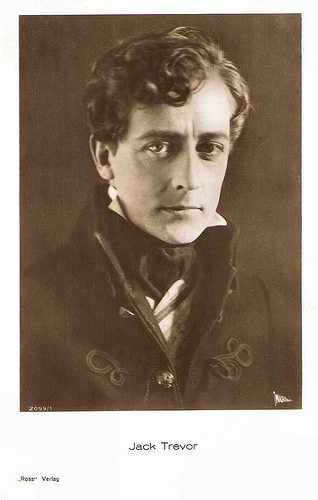
German postcard by Ross Verlag, no. 2099/1, 1927-1928. Photo: National.
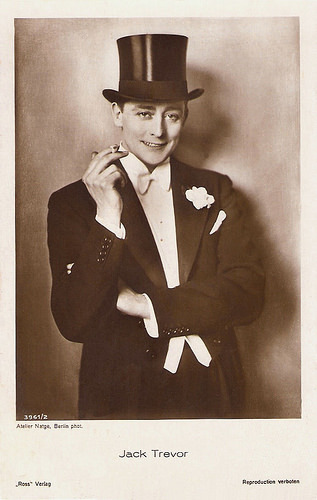
German postcard by Ross Verlag, no. 3961/2, 1928-1929. Photo: Atelier Natge, Berlin.
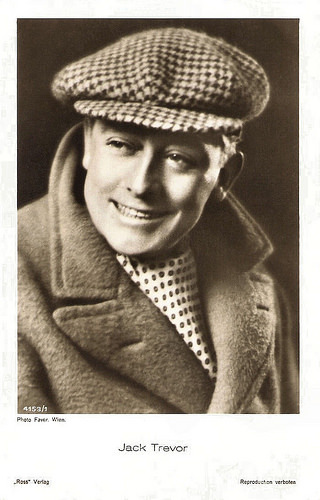
German postcard by Ross Verlag, no. 4153/1, 1929-1930. Photo: Fayer, Wien.
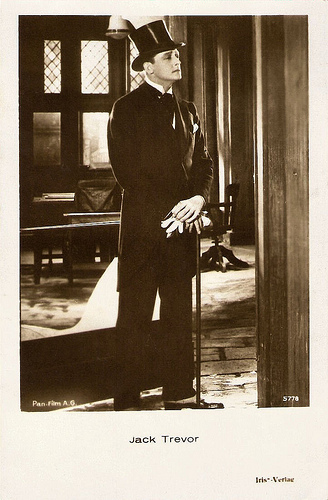
Austrian postcard by Iris-Verlag, no. 5778. Photo: Pan-Film AG.
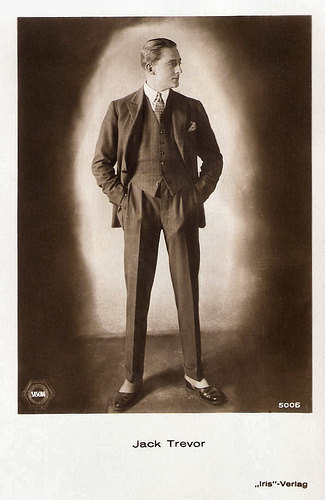
Austrian postcard by Iris-Verlag, no. 5006. Photo: Sascha.
The Typical English Gentleman
Jack Trevor was born as Anthony Cedric Sebastian Steane in London-Lambeth, Great-Britain (according to IMDb in Berlin, Germany) in 1890. He came from a well-to-do, upper-class family and went to study at the New College in Oxford.
During World War I, he served for the Manchester Regiment. He won the Military Cross and was wounded in 1916 which led to his release as a so-called war-disabled person. He married the Austrian Alma, an alleged daughter from the famous liaison between baroness Mary Vetsera and the Austrian Crown Prince Rudolf. His wife committed suicide one year after their wedding.
In the early 1920s Jack Trevor started to work for the silent British cinema in films like Petticoat Loose (George Ridgwell, 1922) with Warwick Ward , and Pages of Life (Adelqui Migliar, 1922) with Evelyn Brent.
After a few years he moved over to the booming German film industry. When Trevor (sometimes credited as Jac Trevor) got a film offer from director Friedrich Zelnik to appear with Hans Albers and Lya Mara in Die Venus von Montmarte/The Venus of Montmartre (1925), he accepted it at once.
That year he also appeared with stars like Lil Dagover , Emil Jannings , Jenny Jugo and Conrad Veidt in Liebe macht blind/Love Makes Us Blind (Lothar Mendes, 1925), and opposite Lily Damita in the hit Fiaker Nr. 13/Cab nr. 13 (Mihaly Kertész aka Michael Curtiz, 1926).
To his other well-known films of the 1920s belong Geheimnisse einer Seele/Secrets of a Soul (Georg Wilhelm Pabst, 1926), Der goldene Schmetterling/The Golden Butterfly (Michael Curtiz, 1926), Die Frau ohne Namen/The Woman Without a Name (Georg Jacoby, 1927), Der Katzensteg/Betrayal (Gerhard Lamprecht, 1927), and Die Liebe der Jeanne Ney/The Love of Jeanne Ney (Georg Wilhelm Pabst, 1927).
In 1928 he appeared in an uncredited part in Alfred Hitchcock’s Champagne (1928) starring Betty Balfour . Trevor always played aristocrats and high officers. In fact he impersonated on screen what he was in his private life: the typical English gentleman.
Other silent films in which he appeared were Moderne Piraten/Modern Pirates (Manfred Noa, 1928), Abwege/Crisis (Georg Wilhelm Pabst, 1928) and Narkose/Narcose (Alfred Abel, Ernst Garden, 1929).
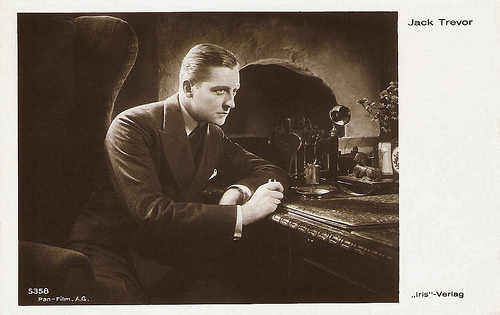
Austrian postcard by Iris Verlag, no. 5358. Photo: Pan-Film A.G.
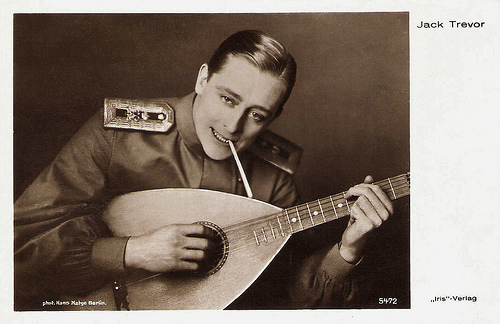
Austrian postcard by Iris Verlag, no. 5472. Photo: Hans Natge, Berlin.
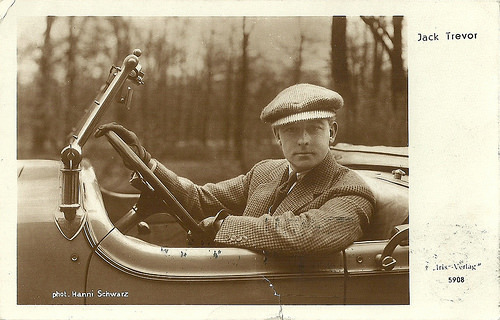
Austrian postcard by Iris Verlag, no. 5908. Photo: Hanni Schwarz.
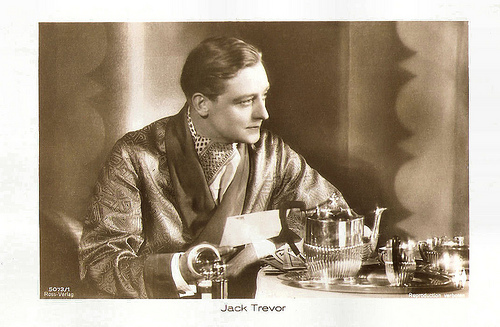
German postcard by Ross Verlag, no. 5073/1, 1930-1931. Photo: Münchner Lichtspielkunst AG (Emelka).
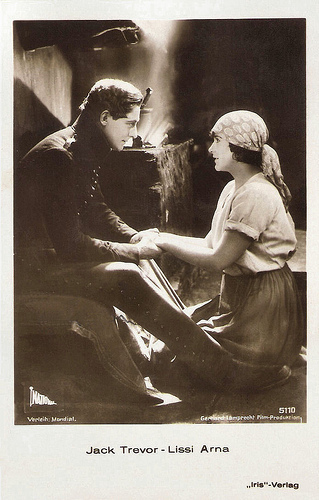
Austrian postcard by Iris Verlag, no. 5110. Photo: National / Mondial / Gerhard LamprechtFilm-Produktion. Publicity still for Der Katzensteg/Betrayal (Gerhard Lamprecht, 1927).
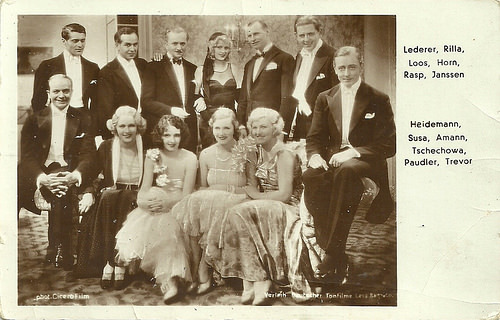
German postcard. Photo: Cicero Film / Distribution Deutsche Tonfilme. The 'fine fleur' of late silent German cinema stars, united for a photo for an early sound film company. Standing left to right: Francis/Franz Lederer, Walter Rilla, Theodor Loos, Camilla Horn, Fritz Rasp and Walter Janssen, Sitting left to right: Paul Heidemann, Charlotte Susa, Betty Amann, Olga Tschechowa, Maria Paudler and Jack Trevor. Might be publicity for the early sound comedy Die grosse Sehnsucht/The Great Longing (Stefan Szekely/Steve Sekely, 1930), in which all acted, mostly as themselves - only Loos and Horn played characters. The plot was an excuse for 35 stars to debut in a talking picture.
Anti-British Propaganda Films
The transition to the sound film turned out to be difficult for Jack Trevor. With his insufficient knowledge of the German language he got only a few roles. He appeared in the war drama Two Worlds (Ewald André Dupont, 1930), the British language version of Les deux mondes (Ewald André Dupont, 1930), and in Die fünf verfluchten Gentlemen/The Five Accursed Gentlemen (Julien Duvivier, 1931), again an alternate language version of a French film, Les cinq gentlemen maudits (Julien Duvivier, 1931).
Later Trevor was able to act more often in supporting roles in such films as Henker, Frauen und Soldaten/Hangmen, Women and Soldiers (Johannes Meyer, 1935) with Hans Albers , Engel mit kleinen Fehlern/Angels with Minor Faults (Carl Boese, 1936) with Adele Sandrock , and Der Scheidungsgrund/Grounds for Divorce (Carl Lamac, 1937) with Anny Ondra .
Trevor, who owned a huge fortune, travelled through Europe with his two sons of his second marriage and didn't pick up much of the political changes in Germany. In 1939, when the war broke out he was arrested and interrogated by the Gestapo, while his family stayed in Oberammergau.
Finally he was forced to take part in anti-British propaganda films like Carl Peters (Herbert Selpin, 1941), Mein Leben für Irland/My Life For Ireland (Max W. Kimmich, 1941) and Ohm Krüger/Uncle Kruger (Hans Steinhoff, 1941) featuring Emil Jannings .
Thomas Staedeli writes at Cyranos that after the war Trevor came in “a vicious circle and was extradited to England”. There he was sentenced to prison for three years because of his support to the Nazis. The sentence was quashed again three months later because it was proved that this collaboration didn't come off of his own free will.
He could turn again to the pleasant sides of life but he never took part in a film again. Jack Trevor died in 1976 in Deal, England. He was 86.
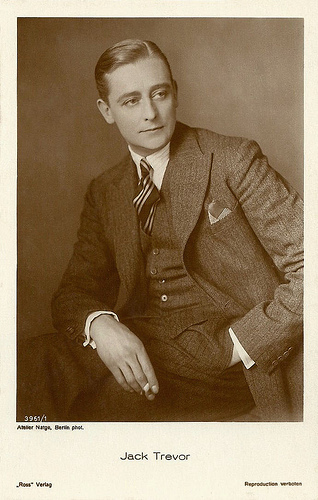
German postcard by Ross Verlag, no. 3951/1, 1928-1929. Photo: Atelier Natge, Berlin.
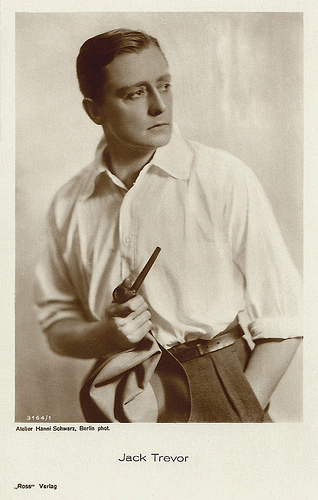
German postcard by Ross Verlag, no. 3164/1, 1928-1929. Photo: Atelier Hanni Schwarz, Berlin.
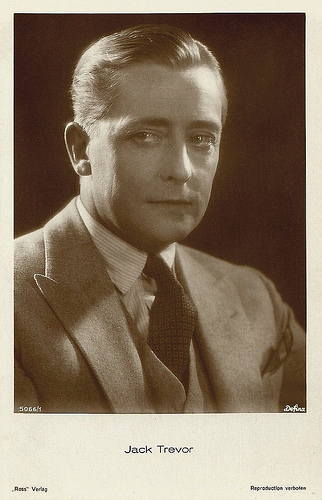
German postcard by Ross Verlag, no. 5066/1, 1930-1931. Photo: Defina.
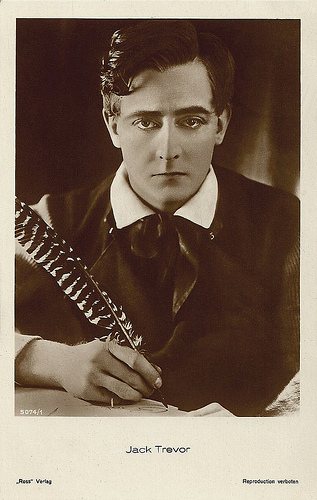
German postcard by Ross Verlag, no. 5074/1, 1930-1931.
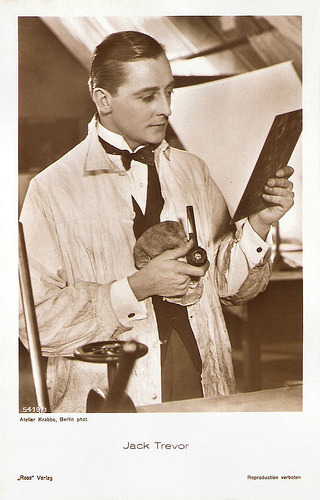
German postcard by Ross Verlag, no. 5419/1, 1930-1931. Photo: Atelier Krabbe, Berlin.
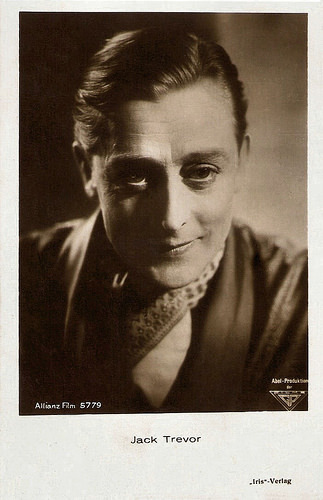
Austrian postcard by Iris-Verlag, no. 5779. Photo: Abel Produktion / GP / Allianz Film.
Sources: Thomas Staedeli (Cyranos), Filmportal.de, Wikipedia and .

German postcard by Ross Verlag, no. 2099/1, 1927-1928. Photo: National.

German postcard by Ross Verlag, no. 3961/2, 1928-1929. Photo: Atelier Natge, Berlin.

German postcard by Ross Verlag, no. 4153/1, 1929-1930. Photo: Fayer, Wien.

Austrian postcard by Iris-Verlag, no. 5778. Photo: Pan-Film AG.

Austrian postcard by Iris-Verlag, no. 5006. Photo: Sascha.
The Typical English Gentleman
Jack Trevor was born as Anthony Cedric Sebastian Steane in London-Lambeth, Great-Britain (according to IMDb in Berlin, Germany) in 1890. He came from a well-to-do, upper-class family and went to study at the New College in Oxford.
During World War I, he served for the Manchester Regiment. He won the Military Cross and was wounded in 1916 which led to his release as a so-called war-disabled person. He married the Austrian Alma, an alleged daughter from the famous liaison between baroness Mary Vetsera and the Austrian Crown Prince Rudolf. His wife committed suicide one year after their wedding.
In the early 1920s Jack Trevor started to work for the silent British cinema in films like Petticoat Loose (George Ridgwell, 1922) with Warwick Ward , and Pages of Life (Adelqui Migliar, 1922) with Evelyn Brent.
After a few years he moved over to the booming German film industry. When Trevor (sometimes credited as Jac Trevor) got a film offer from director Friedrich Zelnik to appear with Hans Albers and Lya Mara in Die Venus von Montmarte/The Venus of Montmartre (1925), he accepted it at once.
That year he also appeared with stars like Lil Dagover , Emil Jannings , Jenny Jugo and Conrad Veidt in Liebe macht blind/Love Makes Us Blind (Lothar Mendes, 1925), and opposite Lily Damita in the hit Fiaker Nr. 13/Cab nr. 13 (Mihaly Kertész aka Michael Curtiz, 1926).
To his other well-known films of the 1920s belong Geheimnisse einer Seele/Secrets of a Soul (Georg Wilhelm Pabst, 1926), Der goldene Schmetterling/The Golden Butterfly (Michael Curtiz, 1926), Die Frau ohne Namen/The Woman Without a Name (Georg Jacoby, 1927), Der Katzensteg/Betrayal (Gerhard Lamprecht, 1927), and Die Liebe der Jeanne Ney/The Love of Jeanne Ney (Georg Wilhelm Pabst, 1927).
In 1928 he appeared in an uncredited part in Alfred Hitchcock’s Champagne (1928) starring Betty Balfour . Trevor always played aristocrats and high officers. In fact he impersonated on screen what he was in his private life: the typical English gentleman.
Other silent films in which he appeared were Moderne Piraten/Modern Pirates (Manfred Noa, 1928), Abwege/Crisis (Georg Wilhelm Pabst, 1928) and Narkose/Narcose (Alfred Abel, Ernst Garden, 1929).

Austrian postcard by Iris Verlag, no. 5358. Photo: Pan-Film A.G.

Austrian postcard by Iris Verlag, no. 5472. Photo: Hans Natge, Berlin.

Austrian postcard by Iris Verlag, no. 5908. Photo: Hanni Schwarz.

German postcard by Ross Verlag, no. 5073/1, 1930-1931. Photo: Münchner Lichtspielkunst AG (Emelka).

Austrian postcard by Iris Verlag, no. 5110. Photo: National / Mondial / Gerhard LamprechtFilm-Produktion. Publicity still for Der Katzensteg/Betrayal (Gerhard Lamprecht, 1927).

German postcard. Photo: Cicero Film / Distribution Deutsche Tonfilme. The 'fine fleur' of late silent German cinema stars, united for a photo for an early sound film company. Standing left to right: Francis/Franz Lederer, Walter Rilla, Theodor Loos, Camilla Horn, Fritz Rasp and Walter Janssen, Sitting left to right: Paul Heidemann, Charlotte Susa, Betty Amann, Olga Tschechowa, Maria Paudler and Jack Trevor. Might be publicity for the early sound comedy Die grosse Sehnsucht/The Great Longing (Stefan Szekely/Steve Sekely, 1930), in which all acted, mostly as themselves - only Loos and Horn played characters. The plot was an excuse for 35 stars to debut in a talking picture.
Anti-British Propaganda Films
The transition to the sound film turned out to be difficult for Jack Trevor. With his insufficient knowledge of the German language he got only a few roles. He appeared in the war drama Two Worlds (Ewald André Dupont, 1930), the British language version of Les deux mondes (Ewald André Dupont, 1930), and in Die fünf verfluchten Gentlemen/The Five Accursed Gentlemen (Julien Duvivier, 1931), again an alternate language version of a French film, Les cinq gentlemen maudits (Julien Duvivier, 1931).
Later Trevor was able to act more often in supporting roles in such films as Henker, Frauen und Soldaten/Hangmen, Women and Soldiers (Johannes Meyer, 1935) with Hans Albers , Engel mit kleinen Fehlern/Angels with Minor Faults (Carl Boese, 1936) with Adele Sandrock , and Der Scheidungsgrund/Grounds for Divorce (Carl Lamac, 1937) with Anny Ondra .
Trevor, who owned a huge fortune, travelled through Europe with his two sons of his second marriage and didn't pick up much of the political changes in Germany. In 1939, when the war broke out he was arrested and interrogated by the Gestapo, while his family stayed in Oberammergau.
Finally he was forced to take part in anti-British propaganda films like Carl Peters (Herbert Selpin, 1941), Mein Leben für Irland/My Life For Ireland (Max W. Kimmich, 1941) and Ohm Krüger/Uncle Kruger (Hans Steinhoff, 1941) featuring Emil Jannings .
Thomas Staedeli writes at Cyranos that after the war Trevor came in “a vicious circle and was extradited to England”. There he was sentenced to prison for three years because of his support to the Nazis. The sentence was quashed again three months later because it was proved that this collaboration didn't come off of his own free will.
He could turn again to the pleasant sides of life but he never took part in a film again. Jack Trevor died in 1976 in Deal, England. He was 86.

German postcard by Ross Verlag, no. 3951/1, 1928-1929. Photo: Atelier Natge, Berlin.

German postcard by Ross Verlag, no. 3164/1, 1928-1929. Photo: Atelier Hanni Schwarz, Berlin.

German postcard by Ross Verlag, no. 5066/1, 1930-1931. Photo: Defina.

German postcard by Ross Verlag, no. 5074/1, 1930-1931.

German postcard by Ross Verlag, no. 5419/1, 1930-1931. Photo: Atelier Krabbe, Berlin.

Austrian postcard by Iris-Verlag, no. 5779. Photo: Abel Produktion / GP / Allianz Film.
Sources: Thomas Staedeli (Cyranos), Filmportal.de, Wikipedia and .
Published on October 15, 2017 22:00
October 14, 2017
Michael Craig
British actor Michael Craig (1928) is known for his work in theatre, film and television both in the United Kingdom and Australia. He also worked as a scriptwriter, such as for The Angry Silence (1960). In Italy, Luchino Visconti directed him in Vaghe stelle dell'Orsa.../Sandra (1965).

Belgian collectors card by Merbotex, Bruxelles. Photo: Arthur Rank.
Groomed for stardom
Michael Craig was born Michael Francis Gregson in Poona, British India, in 1928. He was the son of Donald Gregson, a Scottish captain in the 3rd Indian Cavalry.
He came to Britain with his family when aged three, and went to Canada when he was ten. He left school for the Merchant Navy at 16, but finally returned to England and the lure of the theatre.
By 1947, he debuted on stage in The Merchant of Venice. Craig's film career started as an extra in the Ealing comedy Passport to Pimlico (Henry Cornelius, 1949). In 1953, he gained his first speaking part in the British war film Malta Story (Brian Desmond Hurst, 1953).
This eventually led to discovery by the Rank Organisation. Craig was groomed for stardom, and leading roles followed in such films as Yield to the Night (J. Lee Thompson, 1956) opposite Diana Dors , Campbell's Kingdom (Ralph Thomas, 1957) with Dirk Bogarde , Sea of Sand (Guy Green, 1958) starring Richard Attenborough , The Silent Enemy (William Fairchild, 1958), Upstairs and Downstairs (Ralph Thomas, 1959) with Mylène Demongeot , and the comedy Doctor in Love (Ralph Thomas, 1960).
Hal Erickson at AllMovie : “As leading man in such films, Craig was required to do little more beyond looking handsome and dependable. One of his few movie roles of substance was in The Angry Silence (1960), which he co-wrote.“
The Angry Silence (Guy Green, 1960) starred Richard Attenborough and Pier Angeli . When his 7-year contract with Rank ended, Craig was optioned by Columbia Pictures. Yet his American work was only remembered in two films, ironically co-productions, either with the UK, Mysterious Island (Cy Endfield, 1961), or Australia, the Disney TV instalment, Ride a Wild Pony (Don Chaffey, 1975).
He often worked in Italy and his faraway best Italian film is Vaghe stelle dell'Orsa.../Sandra (Luchino Visconti, 1965) with Claudia Cardinale and Jean Sorel . Other interesting films include Modesty Blaise (Joseph Losey, 1966) featuring Monica Vitti , Star! (Robert Wise, 1968) with Julie Andrews , Turkey Shoot (Brian Trenchard-Smith, 1982), and Appointment with Death (Michael Winner, 1988) with Peter Ustinov and Lauren Bacall.
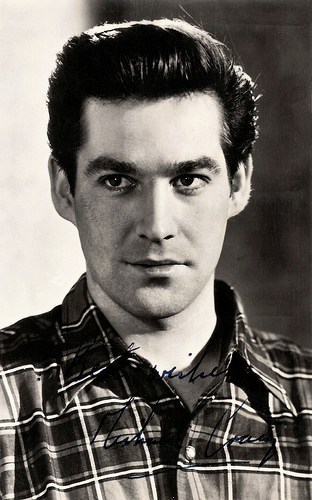
British autograph card. Photo: Rank Organisation.

Austrian postcard by Kellner-Fotokarten, Wien, no. 1075 Ö. Photo: Rank Organisation. Publicity still for House of Secrets (Guy Green, 1956).
Australia
Michael Craig first job in the theatre was as an assistant stage manager at the Castle Theatre, Farnham in 1950. In 1953, Sir Peter Hall gave him his first lead role on stage.
His many later stage credits include A Whistle in the Dark (1961), Wars of the Roses (Season at Stratford 1963-1964), Jule Styne's musical Funny Girl (with Barbra Streisand at the Prince of Wales Theatre 1964), William Shakespeare's play Richard II (1965), The Homecoming (1966–1967) and the lead role in Trying in 2008.
His television credits include appearing in Arthur of the Britons (1973), The Emigrants (1976), Rush (1976), The Professionals (1980), Shoestring (1980), The Timeless Land (1980), Triangle (1981–1983), Tales of the Unexpected (1982), Robin of Sherwood (1986), and Doctor Who (1986).
By the mid-1970s, Craig's TV and film work was heavily concentrated in Australia. He played a depth or roles, both comedic and dramatic, that has included memorable and solid character pieces as he has matured in age. His Australian series include G.P. (1989–1995), Brides of Christ (1991), Grass Roots (2000) and Always Greener (2003).
Craig's scriptwriting credits include the highly acclaimed ABC-TV trilogy The Fourth Wish (1974), which starred John Meillon in his award-winning performance as the father of a dying boy. He also wrote the screenplay for the feature film of The Fourth Wish (1976), which was produced following the success of the television series.
Alongside his brother, Richard Gregson and co-writer Bryan Forbes , Craig was Academy Award nominated for his screenplay of The Angry Silence (1960). Twice married, his first wife was Babette Collier, second is Susan Walker. He is the father of Michael, Stephen and Jessica Gregson.
Michael Craig resides in Australia. His brother is film producer Richard Gregson, and from Richard's marriage to Natalie Wood, he is the uncle of actress Natasha Gregson Wagner. In 2005 Craig released his autobiography The Smallest Giant: An Actor's Tale.
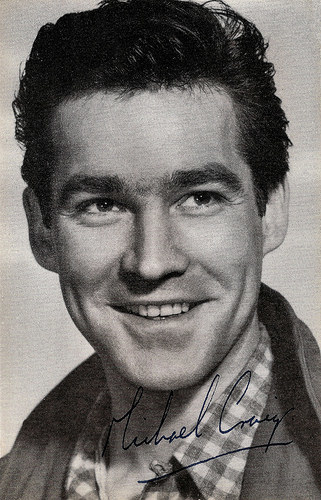
British postcard in the Celebrity Autograph Series by Celebrity Publishers London, no. 298. Photo: Rank Organisation. Publicity still for Campbell's Kingdom (Ralph Thomas, 1957).
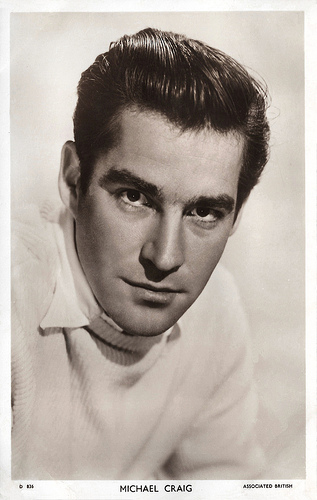
British postcard in the Picturegoer Series, London, no. D 836. Photo: Associated British.
Sources: Hal Erickson (AllMovie), (IMDb), Wikipedia and .

Belgian collectors card by Merbotex, Bruxelles. Photo: Arthur Rank.
Groomed for stardom
Michael Craig was born Michael Francis Gregson in Poona, British India, in 1928. He was the son of Donald Gregson, a Scottish captain in the 3rd Indian Cavalry.
He came to Britain with his family when aged three, and went to Canada when he was ten. He left school for the Merchant Navy at 16, but finally returned to England and the lure of the theatre.
By 1947, he debuted on stage in The Merchant of Venice. Craig's film career started as an extra in the Ealing comedy Passport to Pimlico (Henry Cornelius, 1949). In 1953, he gained his first speaking part in the British war film Malta Story (Brian Desmond Hurst, 1953).
This eventually led to discovery by the Rank Organisation. Craig was groomed for stardom, and leading roles followed in such films as Yield to the Night (J. Lee Thompson, 1956) opposite Diana Dors , Campbell's Kingdom (Ralph Thomas, 1957) with Dirk Bogarde , Sea of Sand (Guy Green, 1958) starring Richard Attenborough , The Silent Enemy (William Fairchild, 1958), Upstairs and Downstairs (Ralph Thomas, 1959) with Mylène Demongeot , and the comedy Doctor in Love (Ralph Thomas, 1960).
Hal Erickson at AllMovie : “As leading man in such films, Craig was required to do little more beyond looking handsome and dependable. One of his few movie roles of substance was in The Angry Silence (1960), which he co-wrote.“
The Angry Silence (Guy Green, 1960) starred Richard Attenborough and Pier Angeli . When his 7-year contract with Rank ended, Craig was optioned by Columbia Pictures. Yet his American work was only remembered in two films, ironically co-productions, either with the UK, Mysterious Island (Cy Endfield, 1961), or Australia, the Disney TV instalment, Ride a Wild Pony (Don Chaffey, 1975).
He often worked in Italy and his faraway best Italian film is Vaghe stelle dell'Orsa.../Sandra (Luchino Visconti, 1965) with Claudia Cardinale and Jean Sorel . Other interesting films include Modesty Blaise (Joseph Losey, 1966) featuring Monica Vitti , Star! (Robert Wise, 1968) with Julie Andrews , Turkey Shoot (Brian Trenchard-Smith, 1982), and Appointment with Death (Michael Winner, 1988) with Peter Ustinov and Lauren Bacall.

British autograph card. Photo: Rank Organisation.

Austrian postcard by Kellner-Fotokarten, Wien, no. 1075 Ö. Photo: Rank Organisation. Publicity still for House of Secrets (Guy Green, 1956).
Australia
Michael Craig first job in the theatre was as an assistant stage manager at the Castle Theatre, Farnham in 1950. In 1953, Sir Peter Hall gave him his first lead role on stage.
His many later stage credits include A Whistle in the Dark (1961), Wars of the Roses (Season at Stratford 1963-1964), Jule Styne's musical Funny Girl (with Barbra Streisand at the Prince of Wales Theatre 1964), William Shakespeare's play Richard II (1965), The Homecoming (1966–1967) and the lead role in Trying in 2008.
His television credits include appearing in Arthur of the Britons (1973), The Emigrants (1976), Rush (1976), The Professionals (1980), Shoestring (1980), The Timeless Land (1980), Triangle (1981–1983), Tales of the Unexpected (1982), Robin of Sherwood (1986), and Doctor Who (1986).
By the mid-1970s, Craig's TV and film work was heavily concentrated in Australia. He played a depth or roles, both comedic and dramatic, that has included memorable and solid character pieces as he has matured in age. His Australian series include G.P. (1989–1995), Brides of Christ (1991), Grass Roots (2000) and Always Greener (2003).
Craig's scriptwriting credits include the highly acclaimed ABC-TV trilogy The Fourth Wish (1974), which starred John Meillon in his award-winning performance as the father of a dying boy. He also wrote the screenplay for the feature film of The Fourth Wish (1976), which was produced following the success of the television series.
Alongside his brother, Richard Gregson and co-writer Bryan Forbes , Craig was Academy Award nominated for his screenplay of The Angry Silence (1960). Twice married, his first wife was Babette Collier, second is Susan Walker. He is the father of Michael, Stephen and Jessica Gregson.
Michael Craig resides in Australia. His brother is film producer Richard Gregson, and from Richard's marriage to Natalie Wood, he is the uncle of actress Natasha Gregson Wagner. In 2005 Craig released his autobiography The Smallest Giant: An Actor's Tale.

British postcard in the Celebrity Autograph Series by Celebrity Publishers London, no. 298. Photo: Rank Organisation. Publicity still for Campbell's Kingdom (Ralph Thomas, 1957).

British postcard in the Picturegoer Series, London, no. D 836. Photo: Associated British.
Sources: Hal Erickson (AllMovie), (IMDb), Wikipedia and .
Published on October 14, 2017 22:00
October 13, 2017
Les Vedettes du Cinéma
French publishing house Éditions Filma created the Les Vedettes du Cinéma series shortly after the First World War. There are circa 70 sepia postcards in the series. We focus in this post on the postcards with French 'vedettes', but the series also contains cards of Hollywood stars like William S. Hart and Mary Pickford. Filma also published another film star series, Les Vedettes de l'écran. On this series we will do a post next Saturday.
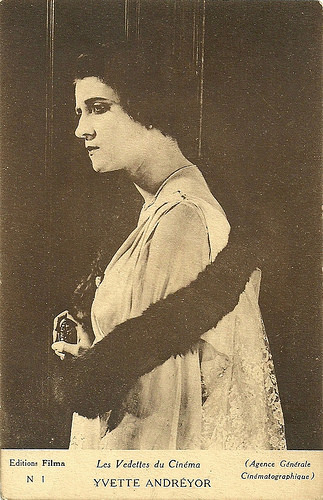
Yvette Andreyor . French postcard in the Les Vedettes du Cinéma series by Éditions Filma, no. 1. Photo: Agence Générale Cinématographique.

Andrée Brabant. French postcard in the Les Vedettes du Cinéma series by Éditions Filma, no. 2. Photo: Agence Générale Cinématographique.
Andrée Brabant (1901-1989) was a charming French film actress whose career peaked in the silent era of French cinema. She was discovered by Abel Gance and also worked with such major directors as André Antoine, Germaine Dulac and Julien Duvivier.
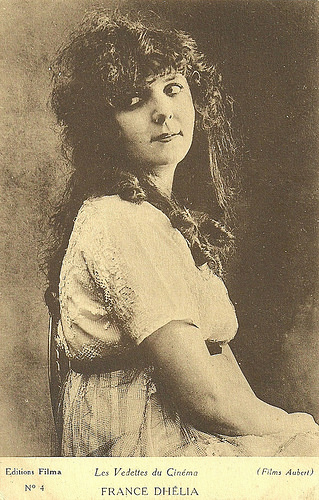
France Dhélia . French postcard in the Les Vedettes du Cinéma series by Éditions Filma, no. 4. Photo: Films Aubert.
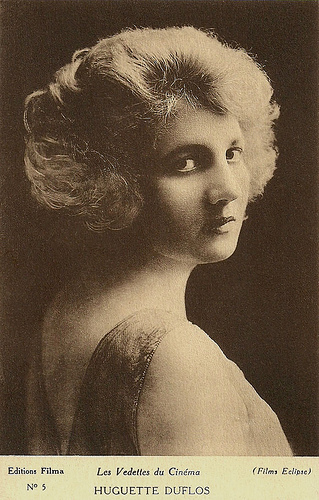
Huguette Duflos . French postcard in the Les Vedettes du Cinéma series by Éditions Filma, no. 5. Photo: Films Eclipse.
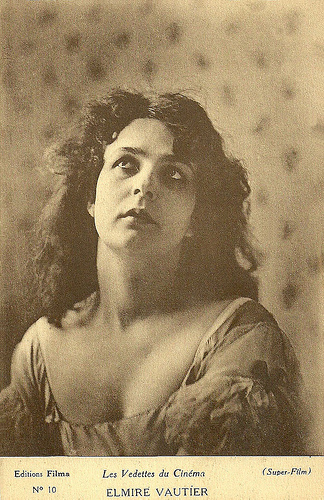
Elmire Vautier . French postcard in the Les Vedettes du Cinéma series by Éditions Filma, no. 5. Photo: Super-Film.
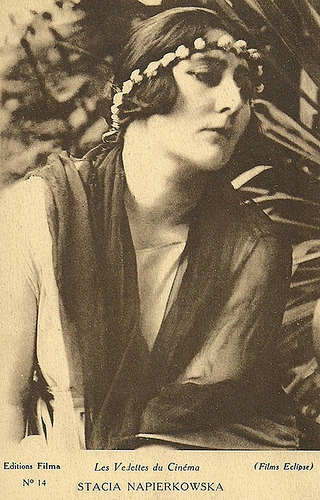
Stacia Napierkowska . French postcard in the Les Vedettes du Cinéma series by Éditions Filma, no. 14. Photo: Films Eclipse.
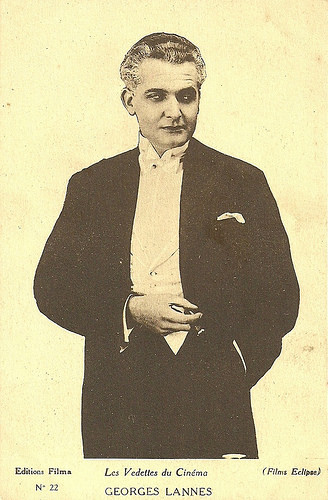
Georges Lannes. French postcard in the Les Vedettes du Cinéma series by Éditions Filma, no. 22. Photo: Films Eclipse.
Georges Lannes (1895–1983) was a French film actor who appeared in more than a hundred films during his career (1920-1961). Lannes peaked with the serial Les Mystères de Paris (Charles Burguet, 1922) in which he had the lead as prince Rodolphe.
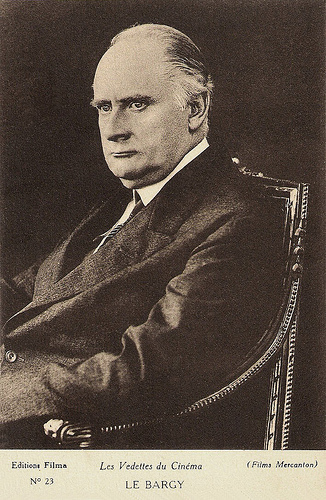
Charles Le Bargy . French postcard in the Les Vedettes du Cinéma series by Éditions Filma, no. 25. Photo: Films Mercanton.
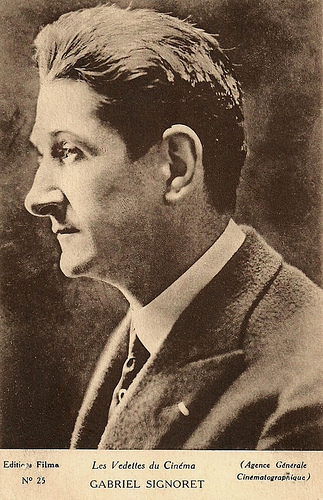
Gabriel Signoret . French postcard in the Les Vedettes du Cinéma series by Éditions Filma, no. 25. Photo: Agence Générale Cinématographique.
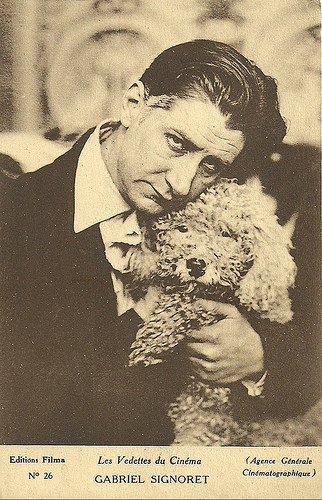
Gabriel Signoret . French postcard in the Les Vedettes du Cinéma series by Éditions Filma, no. 26. Photo: Agence Générale Cinématographique.
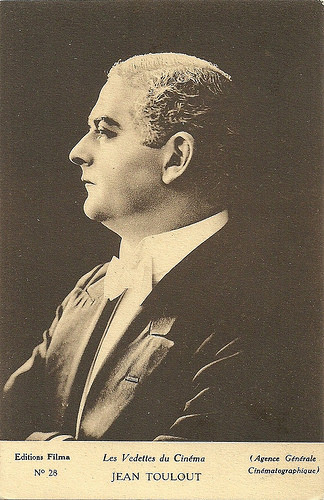
Jean Toulout. French postcard in the Les Vedettes du Cinéma series by Éditions Filma, no. 28. Photo: Agence Générale Cinématographique.
Jean Toulout (1887-1962) was a French stage and screen actor, director and scripwriter. He was married to the actress Yvette Andreyor between 1917 and 1926.
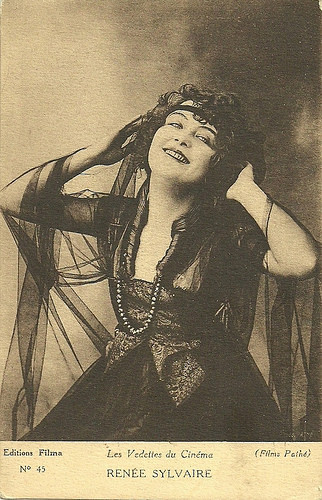
Renée Sylvaire . French postcard in the Les Vedettes du Cinéma series by Éditions Filma, no. 45. Photo: Films Pathé.
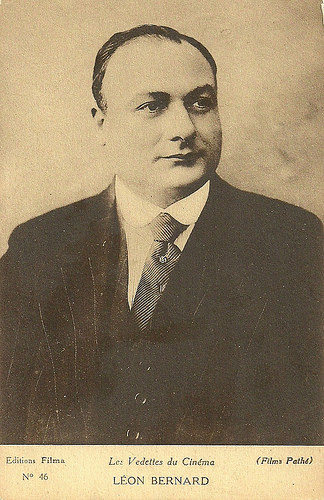
Léon Bernard . French postcard in the Les Vedettes du Cinéma series by Éditions Filma, no. 46. Photo: Films Pathé.
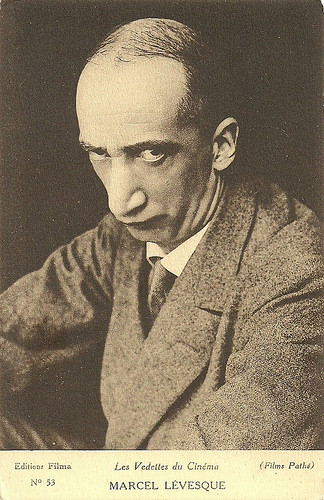
Marcel Lévesque . French postcard in the Les Vedettes du Cinéma series by Éditions Filma, no. 53. Photo: Films Pathé.
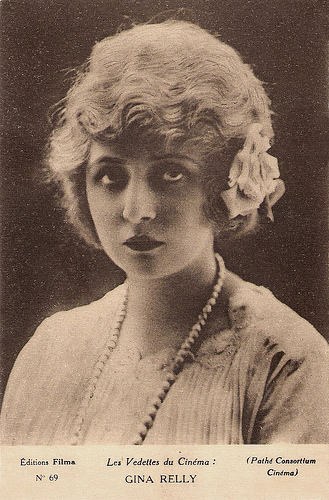
Gina Relly . French postcard in the Les Vedettes du Cinéma series by Éditions Filma, no. 69. Photo: Pathé Consortium Cinema.
Sources: Rosscards.

Yvette Andreyor . French postcard in the Les Vedettes du Cinéma series by Éditions Filma, no. 1. Photo: Agence Générale Cinématographique.

Andrée Brabant. French postcard in the Les Vedettes du Cinéma series by Éditions Filma, no. 2. Photo: Agence Générale Cinématographique.
Andrée Brabant (1901-1989) was a charming French film actress whose career peaked in the silent era of French cinema. She was discovered by Abel Gance and also worked with such major directors as André Antoine, Germaine Dulac and Julien Duvivier.

France Dhélia . French postcard in the Les Vedettes du Cinéma series by Éditions Filma, no. 4. Photo: Films Aubert.

Huguette Duflos . French postcard in the Les Vedettes du Cinéma series by Éditions Filma, no. 5. Photo: Films Eclipse.

Elmire Vautier . French postcard in the Les Vedettes du Cinéma series by Éditions Filma, no. 5. Photo: Super-Film.

Stacia Napierkowska . French postcard in the Les Vedettes du Cinéma series by Éditions Filma, no. 14. Photo: Films Eclipse.

Georges Lannes. French postcard in the Les Vedettes du Cinéma series by Éditions Filma, no. 22. Photo: Films Eclipse.
Georges Lannes (1895–1983) was a French film actor who appeared in more than a hundred films during his career (1920-1961). Lannes peaked with the serial Les Mystères de Paris (Charles Burguet, 1922) in which he had the lead as prince Rodolphe.

Charles Le Bargy . French postcard in the Les Vedettes du Cinéma series by Éditions Filma, no. 25. Photo: Films Mercanton.

Gabriel Signoret . French postcard in the Les Vedettes du Cinéma series by Éditions Filma, no. 25. Photo: Agence Générale Cinématographique.

Gabriel Signoret . French postcard in the Les Vedettes du Cinéma series by Éditions Filma, no. 26. Photo: Agence Générale Cinématographique.

Jean Toulout. French postcard in the Les Vedettes du Cinéma series by Éditions Filma, no. 28. Photo: Agence Générale Cinématographique.
Jean Toulout (1887-1962) was a French stage and screen actor, director and scripwriter. He was married to the actress Yvette Andreyor between 1917 and 1926.

Renée Sylvaire . French postcard in the Les Vedettes du Cinéma series by Éditions Filma, no. 45. Photo: Films Pathé.

Léon Bernard . French postcard in the Les Vedettes du Cinéma series by Éditions Filma, no. 46. Photo: Films Pathé.

Marcel Lévesque . French postcard in the Les Vedettes du Cinéma series by Éditions Filma, no. 53. Photo: Films Pathé.

Gina Relly . French postcard in the Les Vedettes du Cinéma series by Éditions Filma, no. 69. Photo: Pathé Consortium Cinema.
Sources: Rosscards.
Published on October 13, 2017 22:00
Paul van Yperen's Blog
- Paul van Yperen's profile
- 13 followers
Paul van Yperen isn't a Goodreads Author
(yet),
but they
do have a blog,
so here are some recent posts imported from
their feed.



